Upper Mekong River Cruise
Whenever my husband and I listen to Creedence Clearwater Revival’s beautifully melancholic song “Have You Ever Seen The Rain,” we’re transported back to that magical evening on the sandy banks of the Upper Mekong River in Laos, with the cozy, wood-paneled, 28-pax Mekong Sun tied up to a stake in the sand.
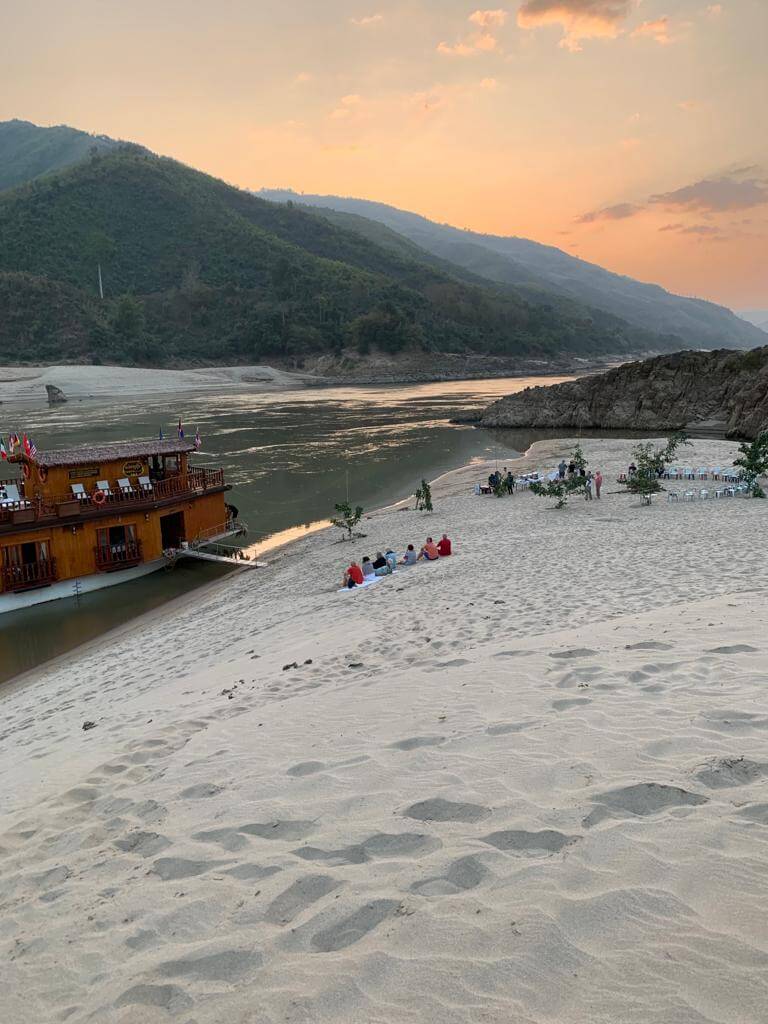
Our mooring for the evening along the sands of the Upper Mekong. * Photo: Heidi Sarna
We were there for the night, enjoying dinner, drinks and live music. The crew built a bonfire with gathered kindling and set a circle of chairs around it. Nearby they grilled chicken, sausages and fish for us and set out a buffet of local vegetables and corn on the cob. Flaming tiki torches gave off atmospheric light under the twinkling night sky, creating a beautiful scene in the middle of glorious nowhere.
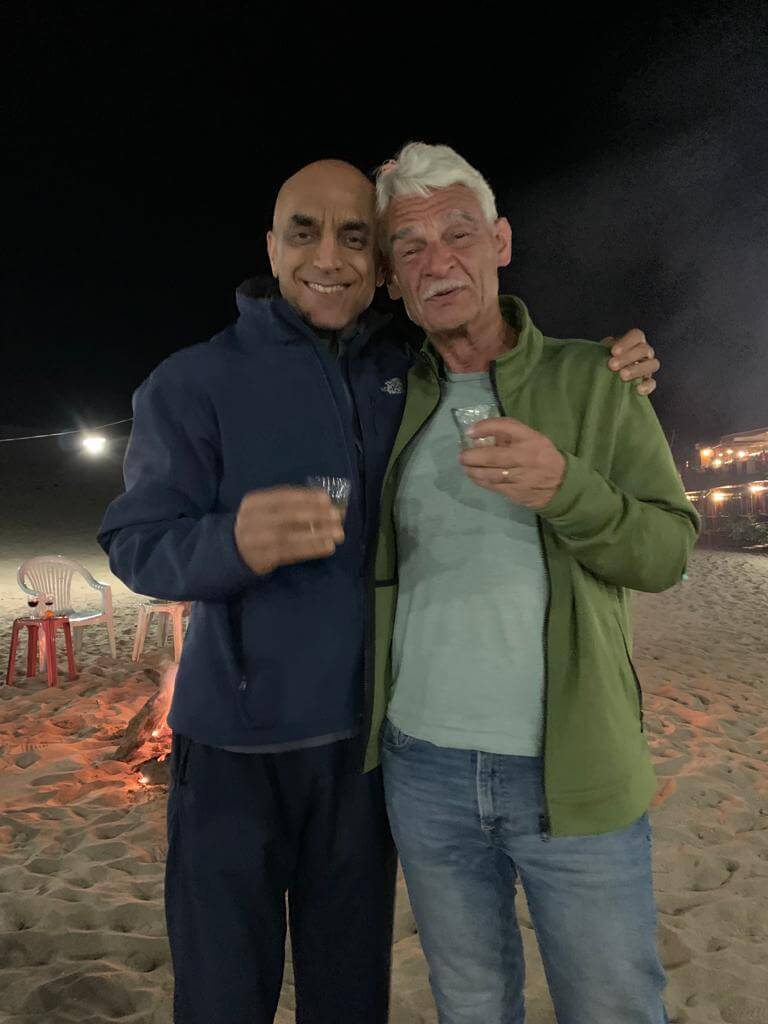
A good time was had by all! * Photo: Heidi Sarna
With our besties from the cruise — charming funny insightful Adriano from Italy (who spoke five languages, or maybe more) and a sweet friendly woman from Germany whose name I now forget — we drank the local rice wine known as Lao Lao ($1 a shot) as well as cheap and cheerful red wine for a few dollars a glass.
Music came courtesy of several Lao crew members, who sang soulful tunes and played acoustic guitar to complete the evening’s mood. The singer was one of the bartenders, and the repertoire he knew in English included that CCR song. My typically reserved husband wound up joining the concert, playing a bongo.
We sang along and reveled in the magic.
Subscribe to our monthly small ship cruise email
Subscribe to QuirkyCruise.com for monthly curated newsletters highlighting our top small cruise ship reviews, round-ups & offers!
What’s An Upper Mekong River Cruise In Laos Like?
When we woke up early on the first full day of our 10-night cruise aboard the Mekong Sun, we knew why Alex the cruise director had called this stretch of the Upper Mekong River, from Laos’ capital Vientiane to the border of Thailand, “the wild Mekong.”
The morning sun came up over the horizon as a giant orange fireball, emerging through mist that floated above the water in dramatic wisps. The river was narrow and curvy here, with clusters of craggy moonscape-like rocks poking up through the water as if dropped from the sky. Prehistoric boulders and striated rock slabs popped out of the water at impossible angles, leaning downstream and stained with the markings of past water levels — a testament to the power of rushing water over the millennia.
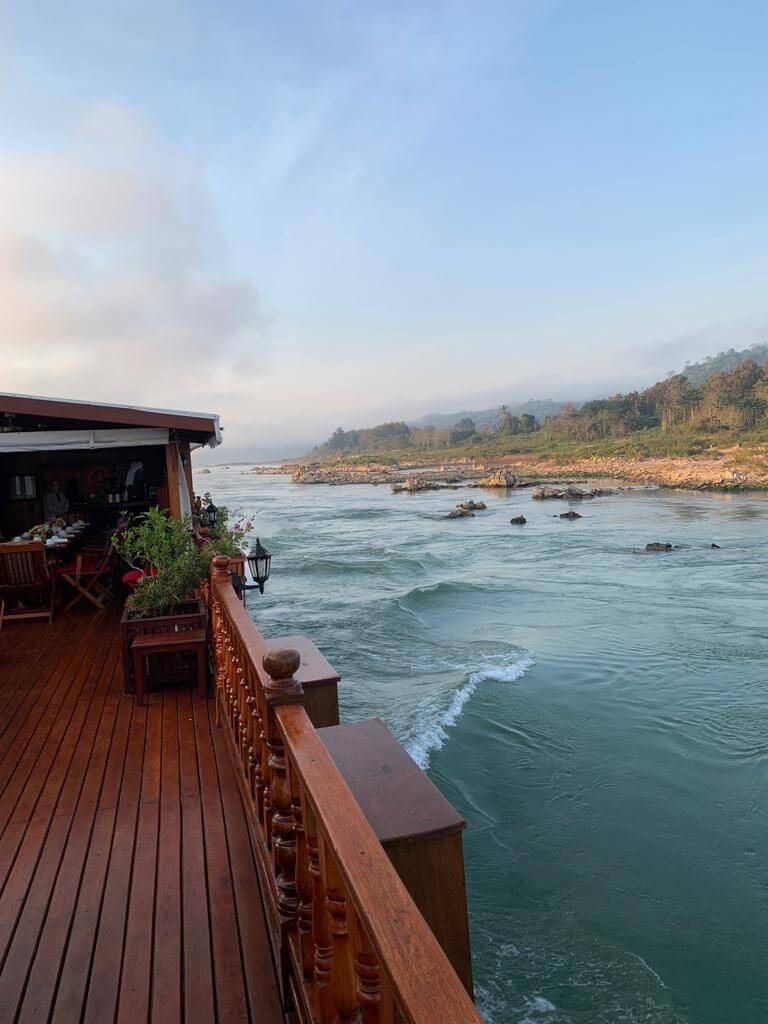
The wild Upper Mekong River waking up. * Photo: Heidi Sarna
It was a mystical, otherworldly scene, a vivid contrast to the Lower Mekong in Vietnam and Cambodia, which is far less scenic and gets lots of commercial and tourist-boat traffic. Throughout our cruise, the river levels at times were quite low, exposing boulders and sand, and there were areas of mini rapids and eddies as the river twisted and moved across its rocky floor.
When needed the captains would slow down the Mekong Sun, easing off the engines to move at a safer pace through the obstacle course. However, in other areas, the river appeared higher and glass-like reflecting the foliage and trees on the banks. It certainly kept us guessing.
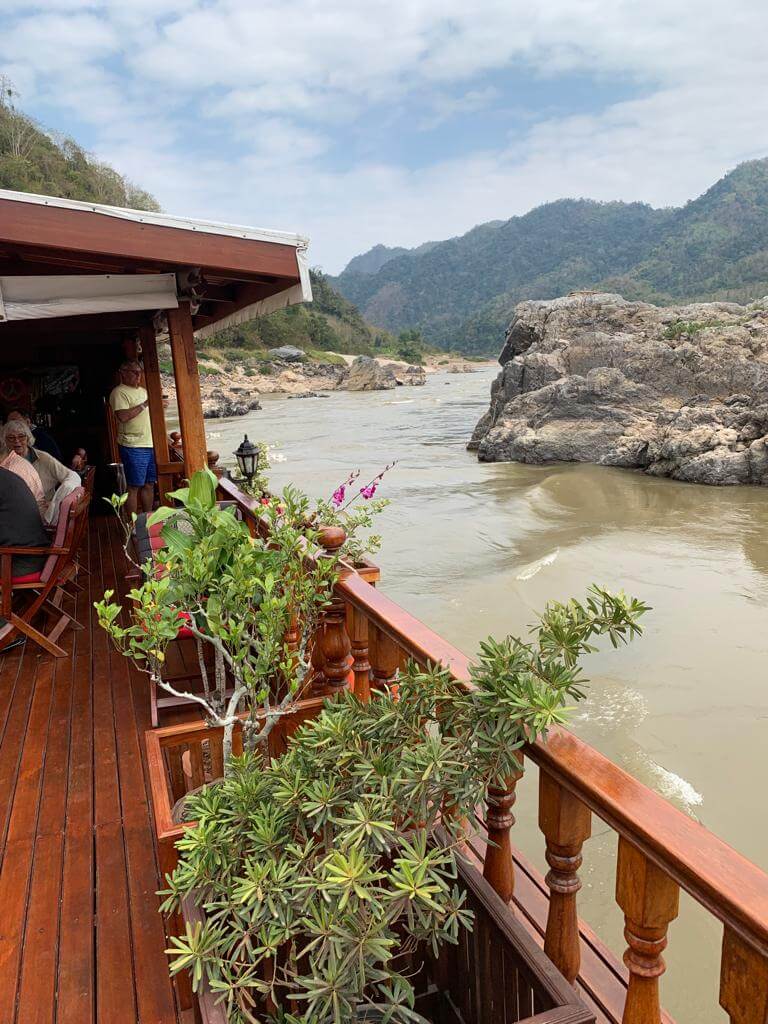
The variable course and countenance of the Upper Mekong kept us guessing. * Photo: Heidi Sarna
Why Are The Mekong’s Water Levels So Low?
The Upper Mekong has been experiencing record-low water levels, with some places less than one meter (three feet). As our cruise director Alex explained, the Mekong used to be dry and low in April and May just before the summer monsoon rains, but over the past decade or so it’s been quite low already in December and January.
Many factors are to blame, but one big one is the many dams being built all along the Mekong — at least 10 of them in China, one in Laos, and another on the Vietnam-Cambodia border, with more being planned. It’s a controversial topic.
How Do Lower Water Levels Affect Upper Mekong River Cruises?
One main way is that cruises can’t always actually start (or end) in Vientiane. Though our cruise was advertised as departing from the Laotian capital that sprawls along the Mekong, we were told upon our arrival that we’d have to meet the boat at a point upstream, a few hours’ drive in a minivan.
Cruise Director Alex told us that generally their two river boats can dock in Vientiane only between September and mid-November.
The first hour of the drive to the Mekong Sun was on a paved road and the second part was on a stony dirt road, in the process of being built or re-built. It was a brain-rattling exercise and miraculous that no tires blew out.
Once we arrived and I laid eyes on her, I could see that our charming wooden river boat oozed charm and adventure. It was just the kind of unusual quirky cruise I appreciate.
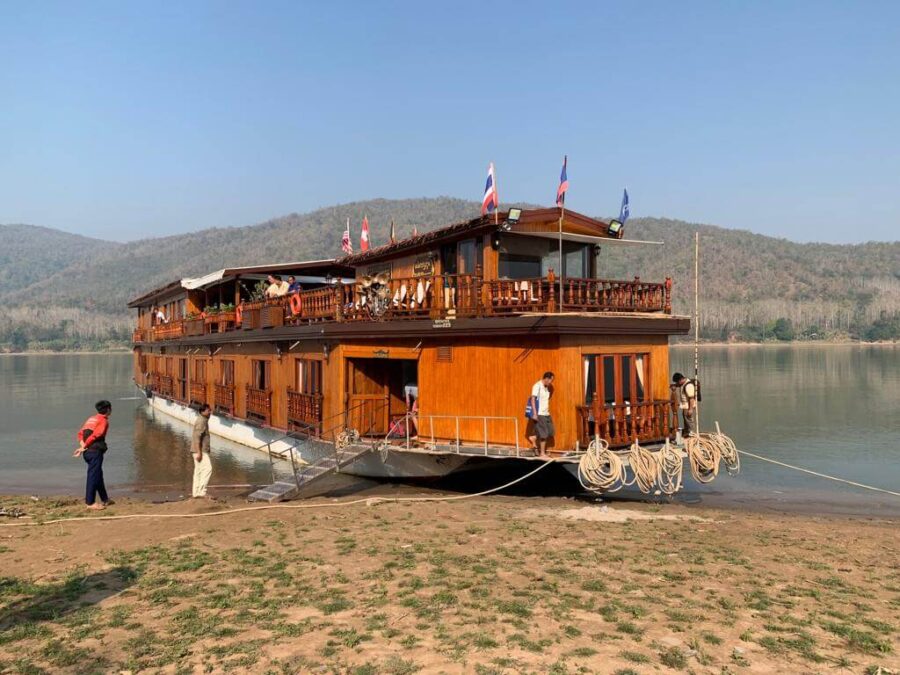
The 28-pax Mekong Sun. * Photo: Heidi Sarna
Our Upper Mekong River Cruise Captains
Our two Lao captains were experts in knowing where to steer the Mekong Sun with its 1.3-meter draft (about four feet) through the Upper Mekong River obstacle course.
The 72-year-old taller captain who chain-smoked was the expert from Luang Prabang to Chiang Rai. Meanwhile his 60-something counterpart knew the Vientiane to Luang Prabang portion best.
They worked as a team, relying on experience and their keen eyesight. There is no radar or sonar used; their “dashboard” consisted of the wheel and controls for the engine and propellor. The captains’ sleeping quarters were behind their chairs.
Everything about this trip was old-school and back to the basics. I loved it!
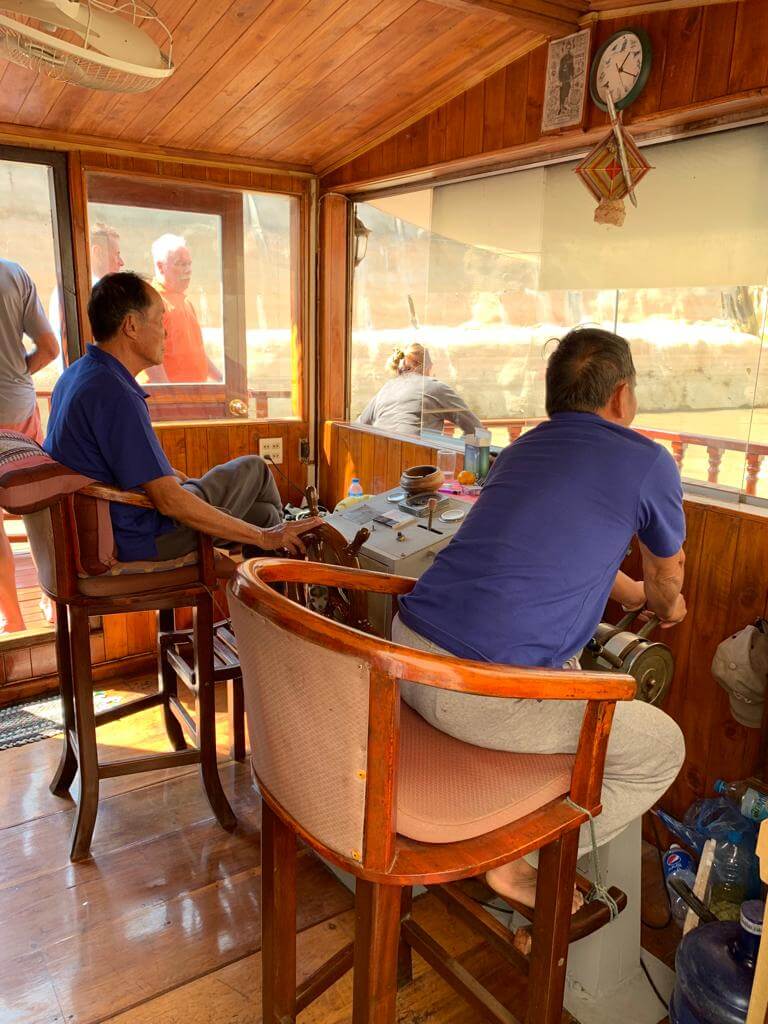
Our two captains at the helm. * Photo: Heidi Sarna
The Scenery Along the Way
Along with the exposed rocks, bands of sand emerged mid-stream at times and in parts lined the riverbanks. Bamboo fences could be seen along distant hillocks, where farmers grew cassava, mountain rice, palms, banana trees and other tropical species. Some areas were cleared for harvest (often burned), awaiting another year of planting. Farming is often done by hand and in some cases with the help of basic Japanese-made tractors.
A few times we saw folks panning for gold at the river’s edge, shaking large pans in the hopes of finding a few bits to sell. As futile as it may appear, crew told us those folks believe it’s preferable to the toil of rice farming.
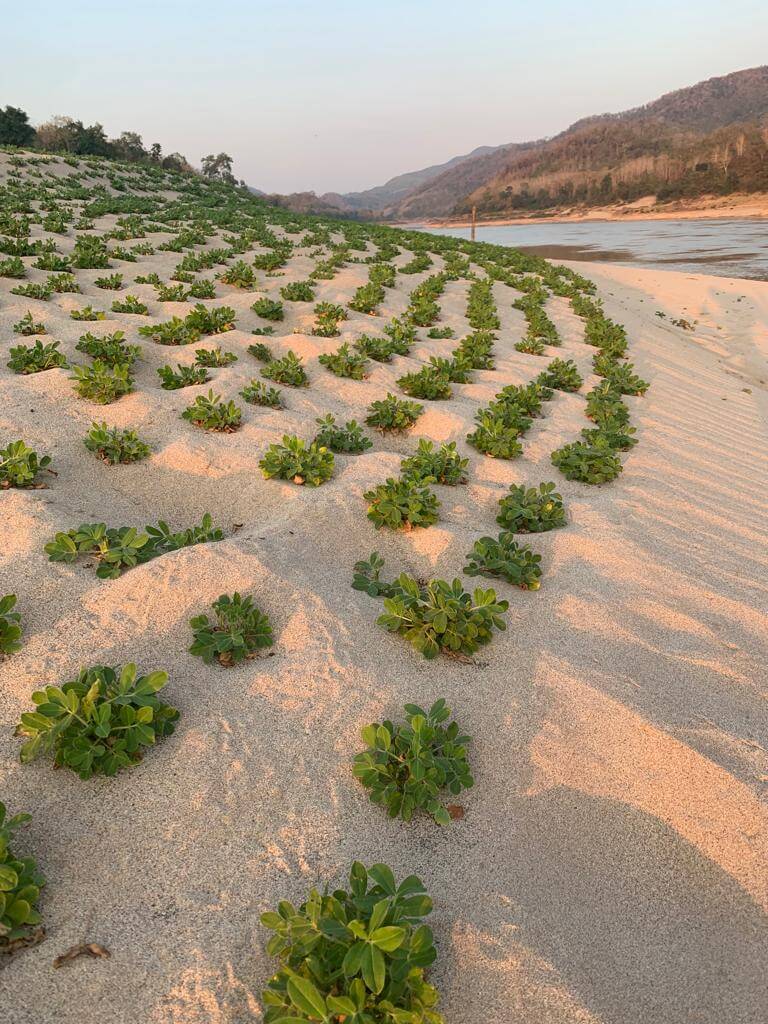
Peanuts planted along the sandy riverbanks. * Photo: Heidi Sarna
For much of the trip, we encountered very few other river boats or skiffs, and no commercial barges like the kinds you see on the Lower Mekong.
The only real “traffic” was an occasional buzz of a skiff with an outboard motor — the exception to that rule being the two days we docked in the city of Luang Prabang, when the river became busier with rattling longboats shuttling monks and locals across the river or taking tourists on sunrise and sunset jaunts.
Unlike those short “cruises,” ours felt like charting new territory, exploring places where few other tourists (or anyone at all) seemed to be. The only other cruise boats we saw were Mekong Sun’s fleetmate Mekong Pearl and boats belonging to Pandaw, the other company that cruises the Upper Mekong.
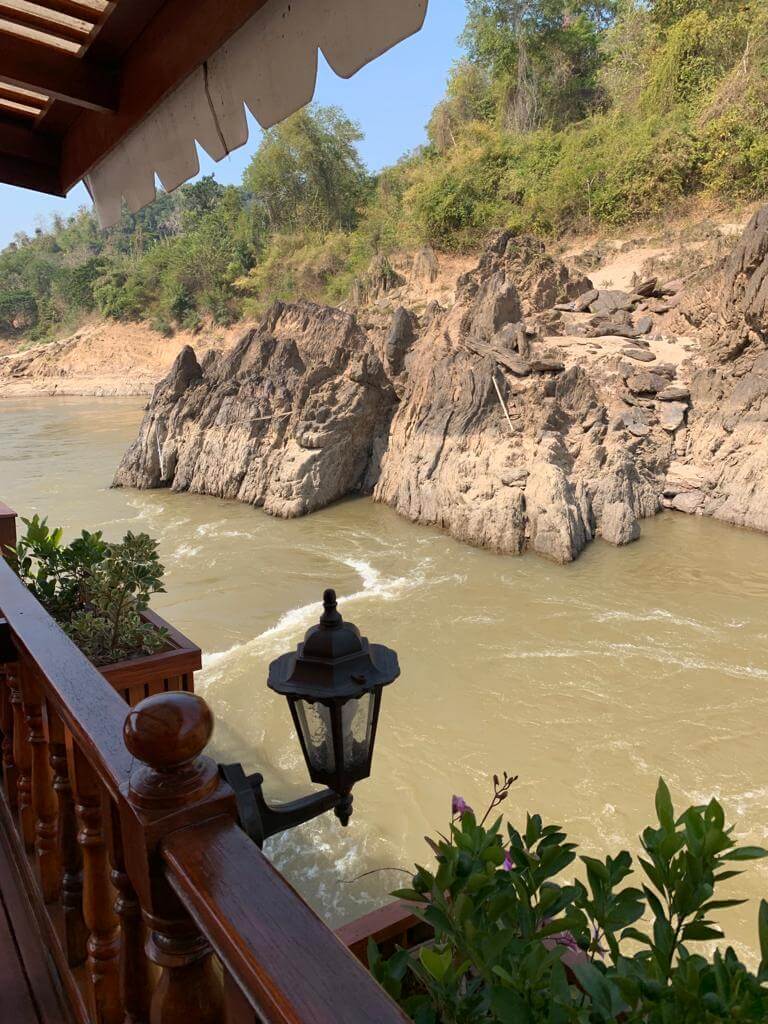
The view from the Sun Deck of our river boat. * Photo: Heidi Sarna
A Snapshot Of Our Upper Mekong River Cruise Itinerary
This is a go-with-the-flow itinerary. Fog or shallow waters will slow things down and adjust the course.
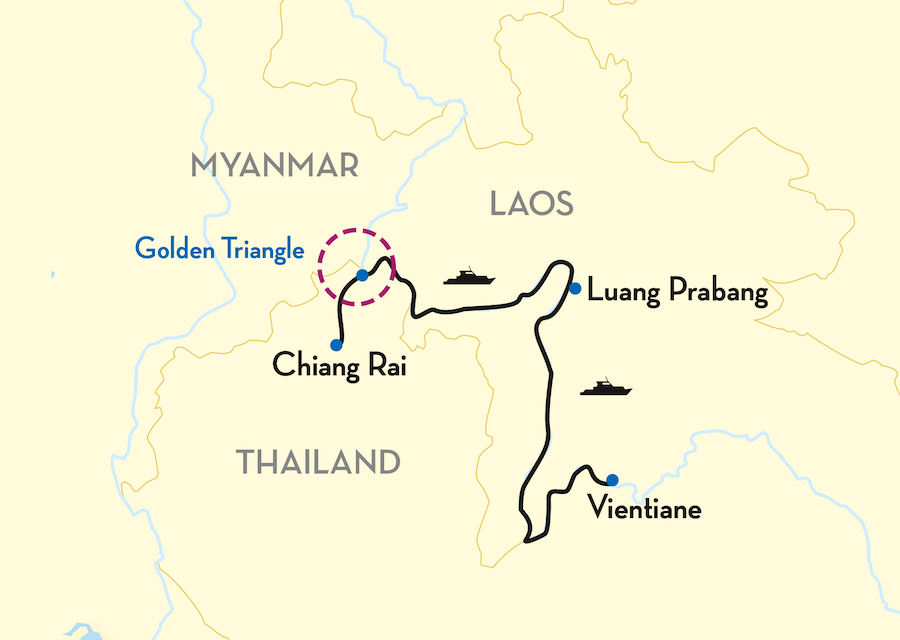
Upper Mekong River Cruise map.
Day 1 — Vientiane, Laos (or vicinity)
While officially our early February cruise was to depart from Vientiane, low water levels on the Mekong between November and March meant the cruise actually started about 60 miles upriver. After a bumpy 2.5-hour drive, we boarded the Mekong Sun near a village called Vang.
Day 2 — Sanakham Village Walk
Touring included visiting a small monastery and a local market by tuk-tuks (auto rickshaws). It was the most underwhelming port stop of the cruise, the market comprising just a dusty group of covered, open-air stalls where folks reclining on lawn chairs and looking at their phones sold cheap clothes, shoes, plastic housewares and fresh fruits and vegetables.
Day 3 — Tham Pabeuk “Secret” Cave Walk
After a fascinating morning cruising the curving, rocky river, we docked post-lunch and walked along a dirt road for about 30 minutes, ascended a short steep path through the brush and donned headlamps to explore a cave.
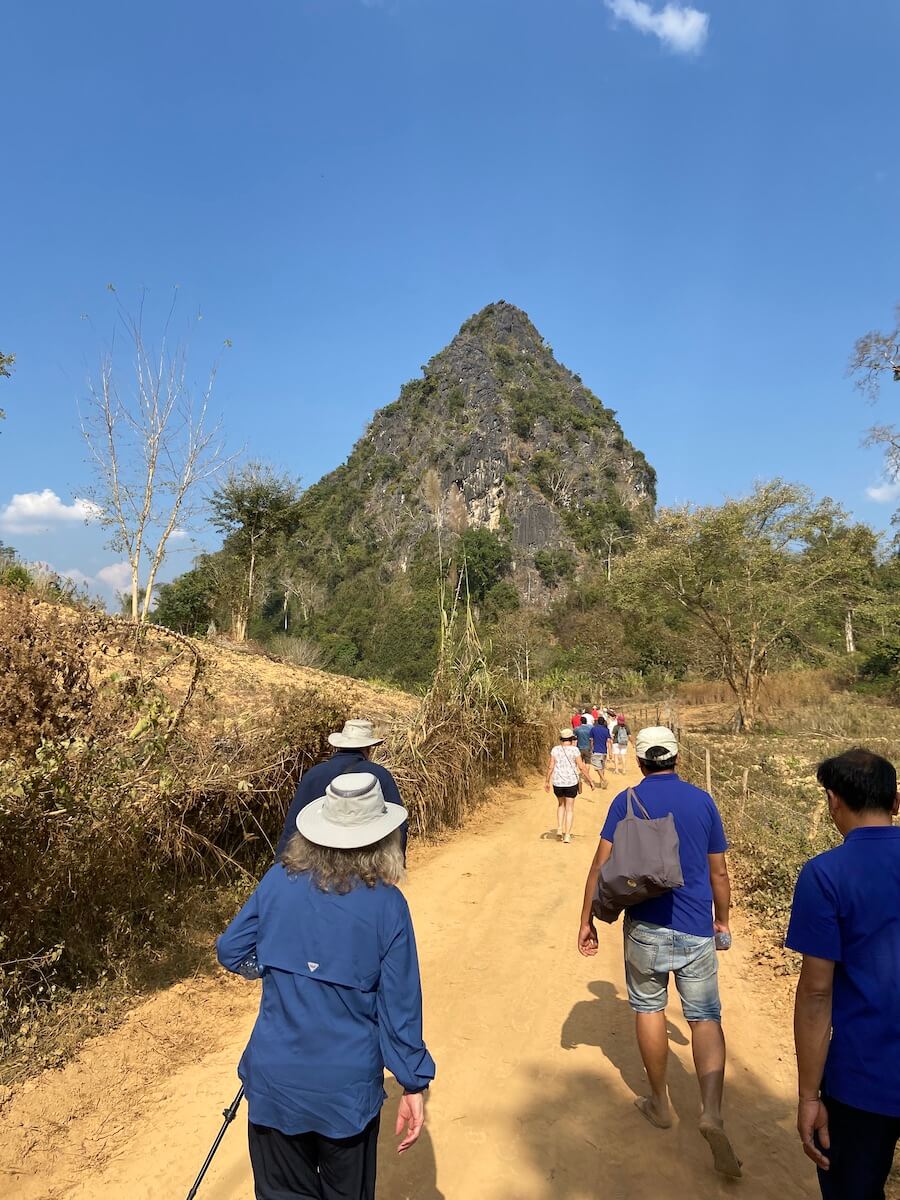
Our walk to the secret cave. * Photo: Heidi Sarna
Day 4 — Sayabury (Xayabouri) Dam & Village Walk
To get past the largest hydroelectric dam in Laos, Mekong Sun had to enter the steep-sided chambers of the dam’s navigation locks. It was a fascinating exercise to watch the chamber fill up with water to get us to the upper level of the river and back on our way.
Day 5/6 — Luang Prabang & Walking Tours
We had two full days in the pretty Lao city of Luang Prabang, a UNESCO World Heritage site and ancient royal capital located at the confluence of the Mekong and Nam Khan rivers. There were several tours to choose from each day, with excellent local guides. We had dinner one evening in town, enjoying a delicious meal of rice, curry and vegetables.
Day 7 — Pak Ou Caves & Ban Mueng Keo Village
We enjoyed scenic cruising in local longboats to visit the Pak Ou Caves, where hundreds of buddha statues are tucked into stone niches. Later in the day, there was time to swim in the Mekong, which about five passengers chose to do (including my hubby).
Day 8 — All-Day Cruising with Dinner & Bonfire on Sandy Riverbanks
In the morning we had to cross a patch of notoriously tenacious rapids. The captains tried to gun it up the rapids with the engines in full throttle, yet we barely moved. A strong motorized local longboat was eventually called to pull us through. After the longboat’s crew tossed across a rope with a bucket on one end (to grab), our crew tied the rope to our bow and we were pulled through the twisty shallow rapids, inch by inch. In the evening, that memorable dinner was set up on the beach, complete with a bonfire, music and drinks.
Day 9 —Kuang Si Waterfalls
We spend several hours at the tiered waterfalls, popular with local tourists, followed by time for swimming or trekking around the park, including hiking to the top of the waterfalls along a jungle path. We saw sun bears in a large enclosure, which were part of a rehabilitation project.
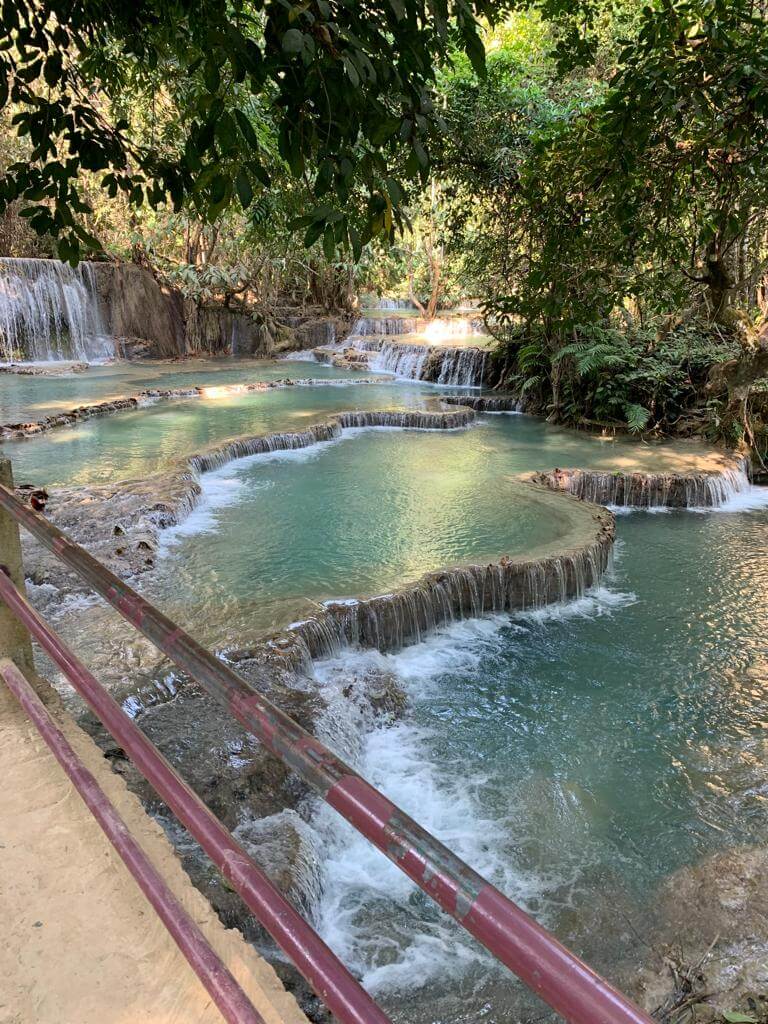
Kuang Si Waterfalls. * Photo: Heidi Sarna
Day 10 — Tuk-Tuk Ride & Village life
On the last day, we docked near small villages, hopping in local tuk-tuks for a short drive along dusty dirt roads pocked with potholes. The ride was an adventure in and of itself. We visited a basic school where the master lined up the children in military fashion.
We walked through the village, past wooden huts and homes on stilts (to protect inhabitants from flooding during rainy season and also from critters like snakes and rodents), some quite dilapidated.
Day 11 — Ban Huay Xay, Laos (at Thai border)
The morning of debarkation, the Mekong Sun docked at Ban Huay Xay, in Laos, very near to the border with Thailand (Chiang Khong) and Myanmar, in the area called the Golden Triangle. After a morning tour of the town, we were taken across one of the region’s “friendship bridges” that connect Laos and Thailand. From Thailand, folks dispersed for more touring in Chiang Rai, Chiang Mai, Bangkok or other locations.
On the way to our hotel in Chiang Rai, a tour of the Hall of Opium Museum was included — a fascinating, propaganda-heavy look at the region’s international opium trade over the centuries and what Thailand has done to mitigate it.
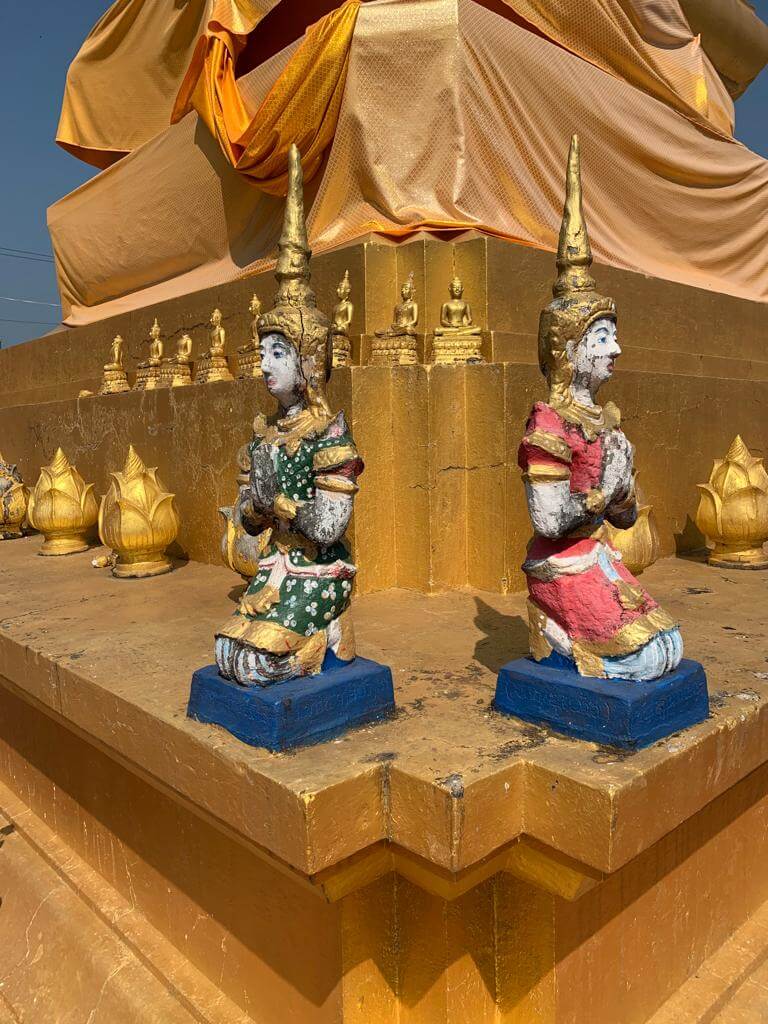
At the Wat That Suvanna Pakham (temple) in Ban (village) Huay Xay. * Photo: Heidi Sarna
Highlights Of My Upper Mekong River Cruise
The River Itself
Besides two days in charming Luang Prabang (with a population of about 60,000 people), the river itself was the main attraction of this cruise.
Its ever-changing landscape was sometimes dotted with exposed grey and sandy-colored boulders. Other areas had striated lengths and clusters of rock, and large and small strips of sand. The river would go from narrow to wide back to narrow again, occasionally making a near 90-degree turn and sometimes flowing around river islands. As we made our way upstream, we passed through gorge-like terrain as well as more mountainous areas with large hillocks.
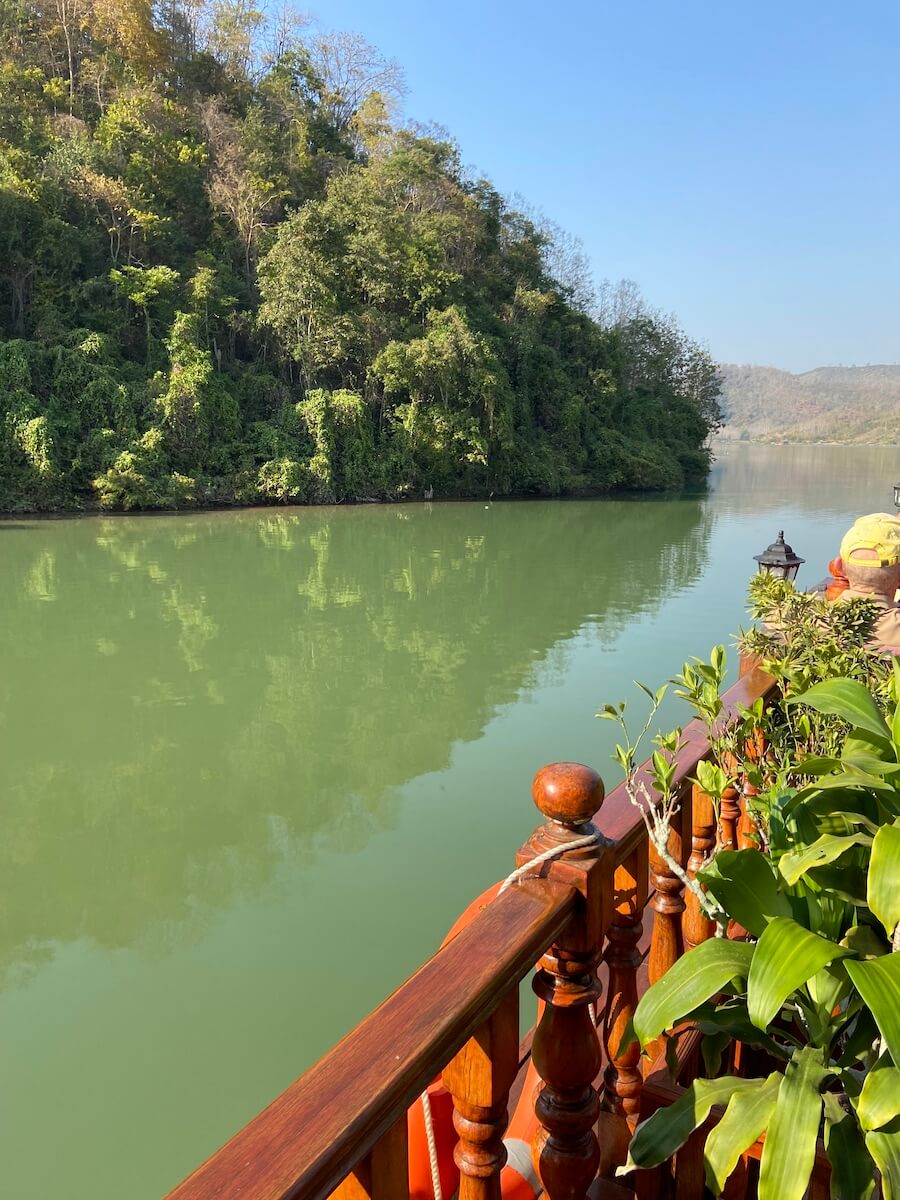
At times the river appeared deep and flat and mirror-like. * Photo: Heidi Sarna
The engines would slow to a murmur in areas that required more delicate maneuvering before revving up again to speed through more easily navigable waters.
At times we saw buffalos and cows grazing along the water’s edge, and fishing lines tied to rocks and to plastic containers to lure milk fish, catfish, and other varieties. Occasionally the faraway squeal of children’s voices playing or calling hello floated across the distance.
At the start of the cruise and again at the end, the Upper Mekong followed the border between Thailand and Laos. Once or twice we passed small towns and tourist spots on the Thai side, where things got a bit busier; Thailand is a much more prosperous, developed and populous country, with 78 million residents, more than ten times that of Laos.
Overall, there very was little commercial traffic on the Upper Mekong, and none once we passed to the north side of the dam. “Taxi” longboats would pass by now and again, making the long trips between Luang Prabang and the Thai border. A few ferried people across the river at points, making up for the lack of bridges — of which we saw only two or three during our entire 780-km journey.
The forever-changing terrain and river levels would continue to awe us again and again over our 10-night journey, set against the shush of the Mekong Sun pushing through the water, the ambient hum of the boat’s engines, the creaking of wooden decks, the shuffling of slippers (which are provided in the cabins), the gong of the mealtime bell, and occasional birdsong from a wee warbler who alighted onto the boat’s railings.
Simplicity, back to basics, raw beauty: just my kind of quirky cruise.
The Excursions — My Favorites
We stopped once or twice daily on all but one day, typically for an hour or two. We’d scurry up the muddy embankment where the Mekong Sun was tied off to a clump of trees, before walking or hopping into a convoy of five or six tuk-tuks waiting to take us to our destination.
There wasn’t always much explanation before excursions, which added to the anticipation (though I would have liked more details).
Several times we took walks with Alex and one or two other crew members through remote villages, which usually included a visit to the village school, where the Mekong Sun crew always distributed school supplies. All the schools comprised just a few wooden rooms with chalk boards and stools. We learned that children can attend free of charge for four years, but after that their families must pay.
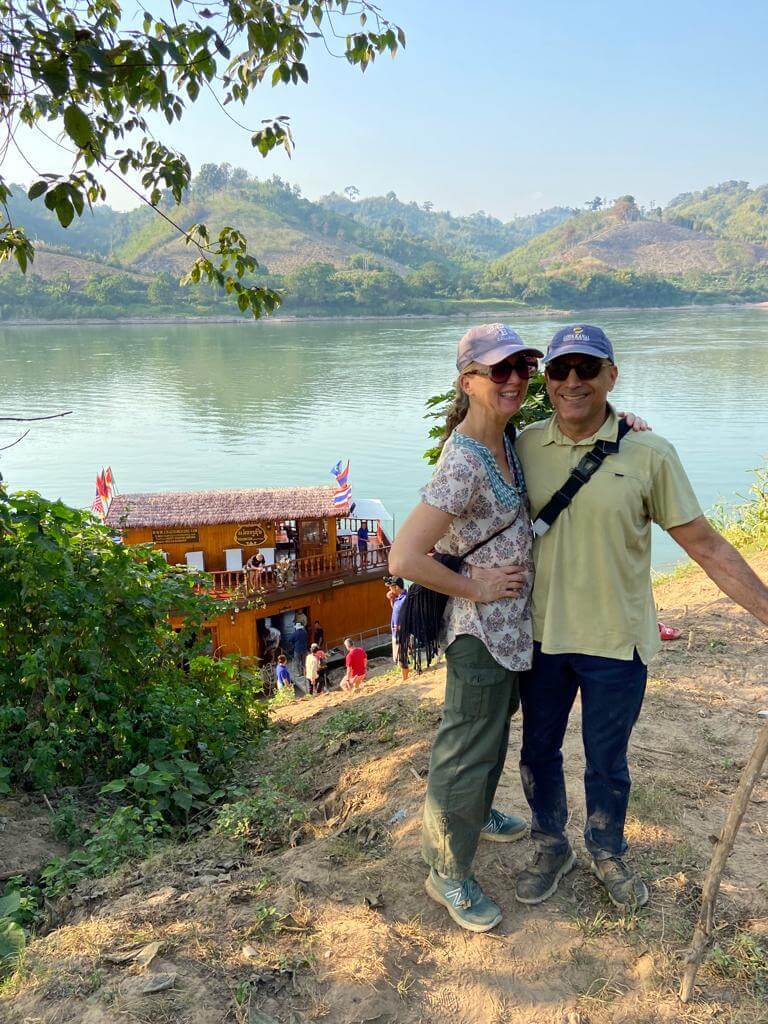
At the start of our trek, with the Mekong Sun below. * Photo: Heidi Sarna
Trek To A Secret Cave
After a short climb up a jungly hillock to get to the entrance, we were given headlamps and Alex and another crew member led anyone interested into the pitch-black limestone karst cave for a look around. I couldn’t help but recall the Thai soccer team who wandered into a similar cave, not so far from where we were, and whose rescue riveted the world.
It was a satisfying excursion, and great to get some exercise.
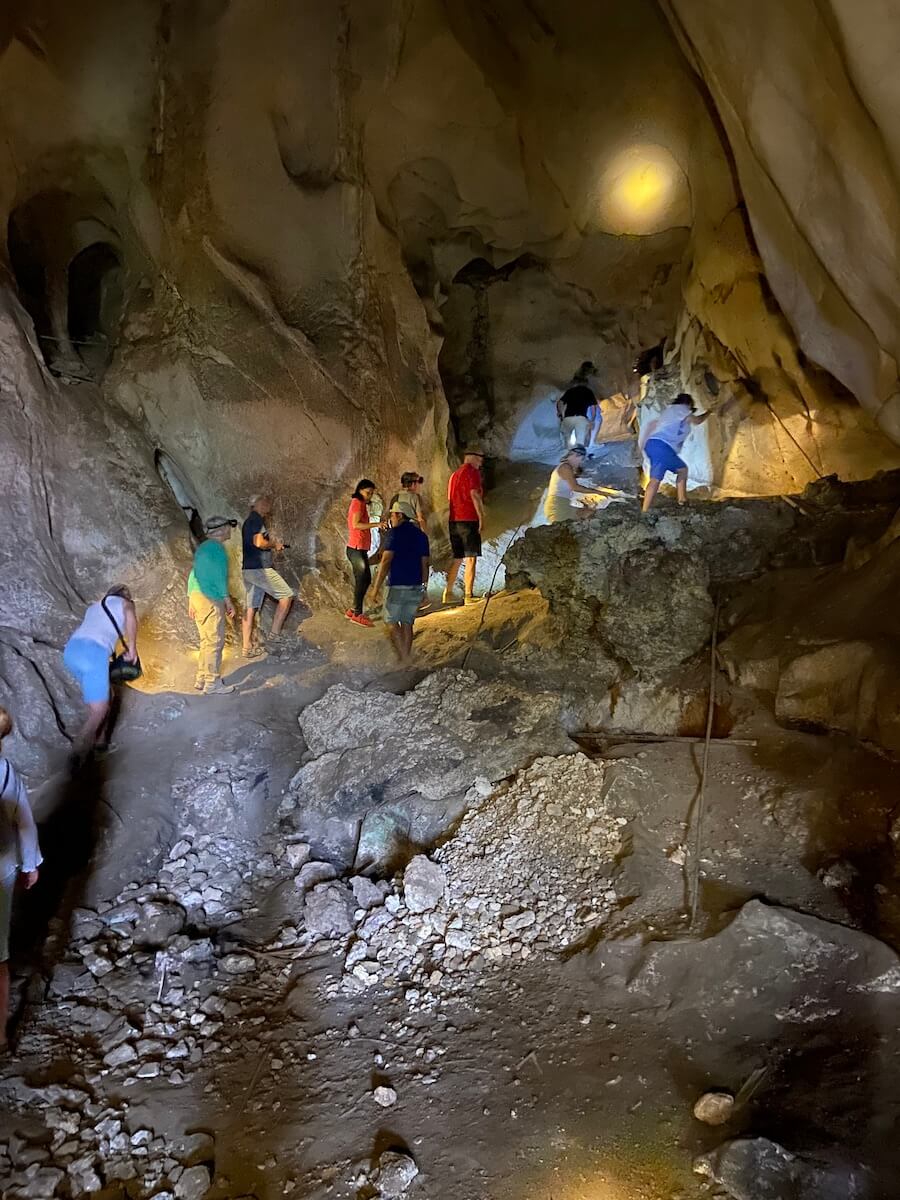
Into the cave we go, with headlamps on. * Photo: Heidi Sarna
Pak Ou Caves & Lao Lao Making Village
Another good day was the Pak Ou caves, where hundreds of buddha statues have been placed in niches over the past century or two. You enter by walking up several flights of stairs just a few steps from where our longboat tied up; luckily we were finished with our visit just as several other tourist boats arrived.
Our group also took the longboat on a short trip down the Ou River (which eventually reaches China) to see some beautiful sheer rock faces and then to a beach to feed bananas to a 21-year-old elephant that worked at a nearby logging camp. We were told the elephants would come to the beach for bathing from time to time — and to be fed bananas by gaggles of giggling tourists! She wasn’t chained up, but controlled by a mahout (rider).
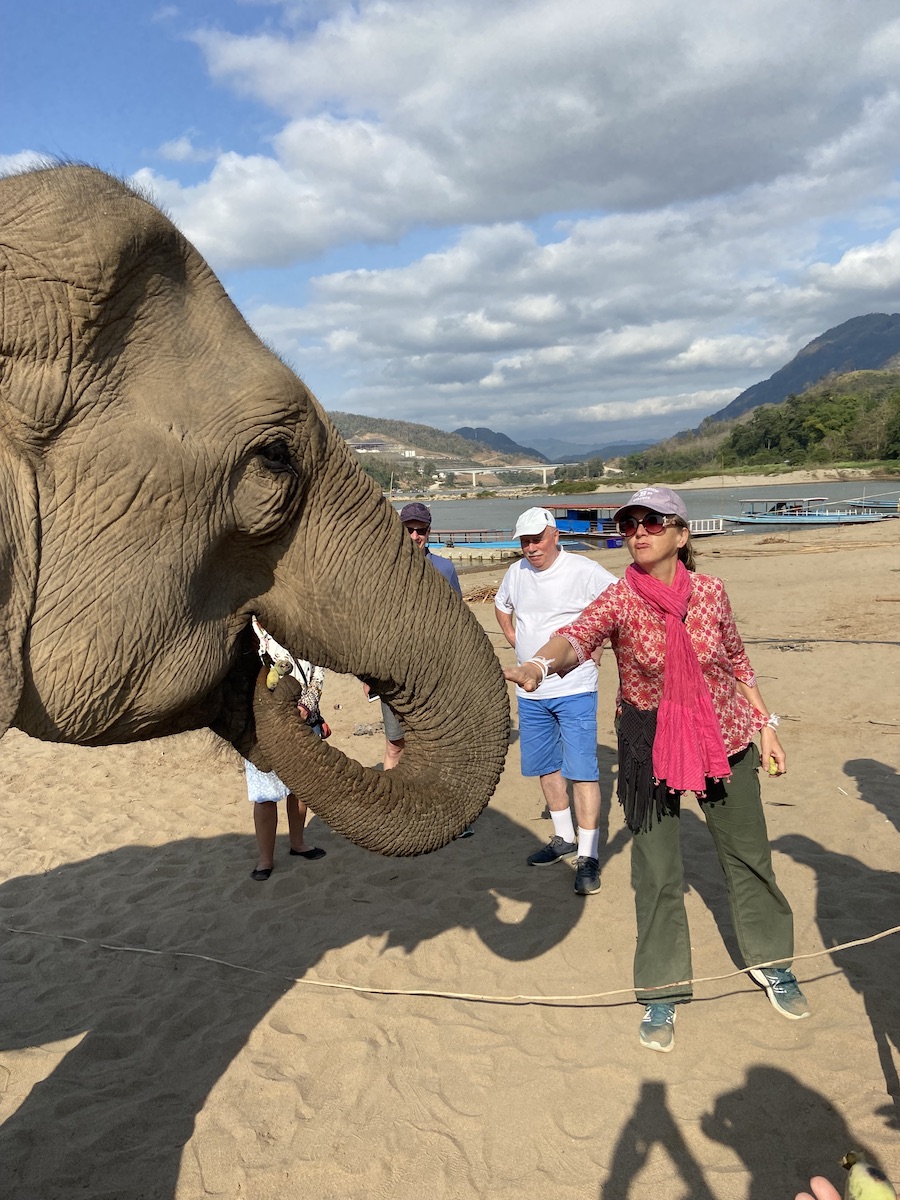
Heidi and the elephant. * Photo: Heidi Sarna
Next it was back in the longboat to visit the nearby village of Ban Mueng Keo to see how the local hooch, Lao Lao (a potent rice wine), is produced, with free samples and bottles for sale at 20,000 kip ($1) per bottle.
Finally, later in the day before dinner, the boat tied up on a sand bank and we could get out to swim in the Mekong and walk around in the soft, wind-patterned sand.
The Pretty City of Luang Prabang
This picturesque small city is set on the bend in the Mekong River, where it meets the Nam Khan River. Luang Prabang is well known for its many Buddhist temples and monasteries, most dating back to the 1700 to 1900s, which co-mingle with restored colonial villas (many now hotels or restaurants) on charming tree-lined streets. There are also outdoor markets to explore.
Luang Prabang’s well-preserved colonial architecture reflects the decades of French colonization from the late 19th century into the early 20th, including the Haw Kham Royal Palace and the gilded Wat Xieng Thong temple. The heart of Luang Prabang is a UNESCO World Heritage Site.
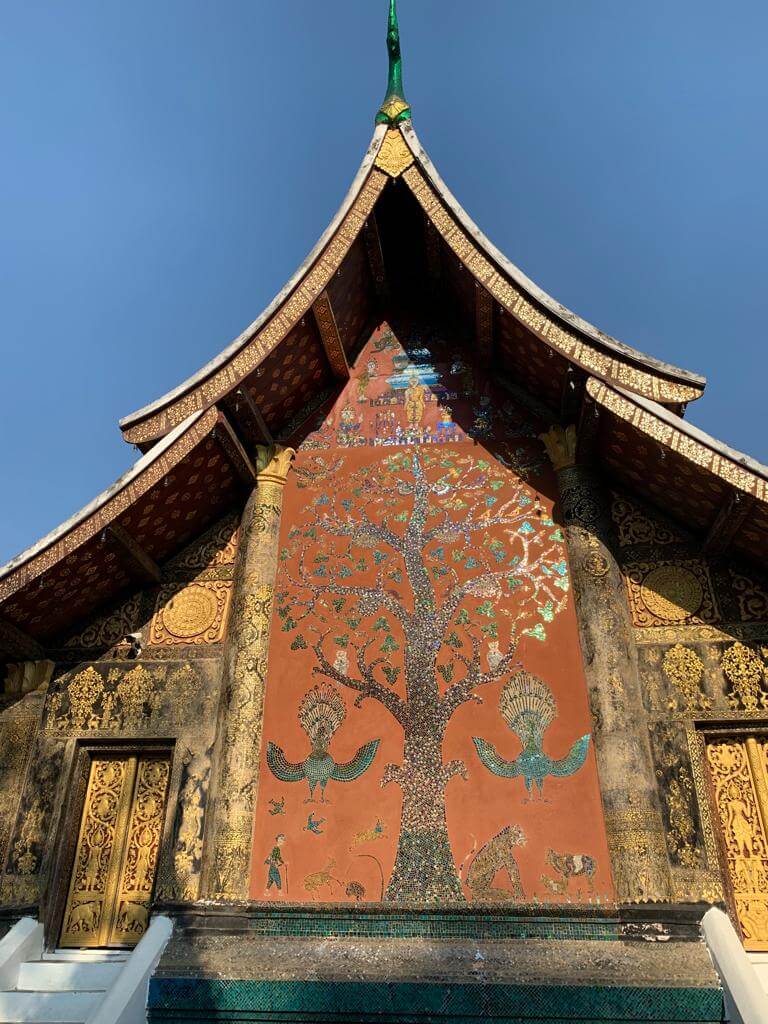
The beautiful exterior of the Wat Xieng Thong temple in Luang Prabang. * Photo: Heidi Sarna
There were several walking tours to choose from each day (included in the fares) with excellent local guides for both English and German speakers, taking us to the famous monasteries and the city’s street markets.
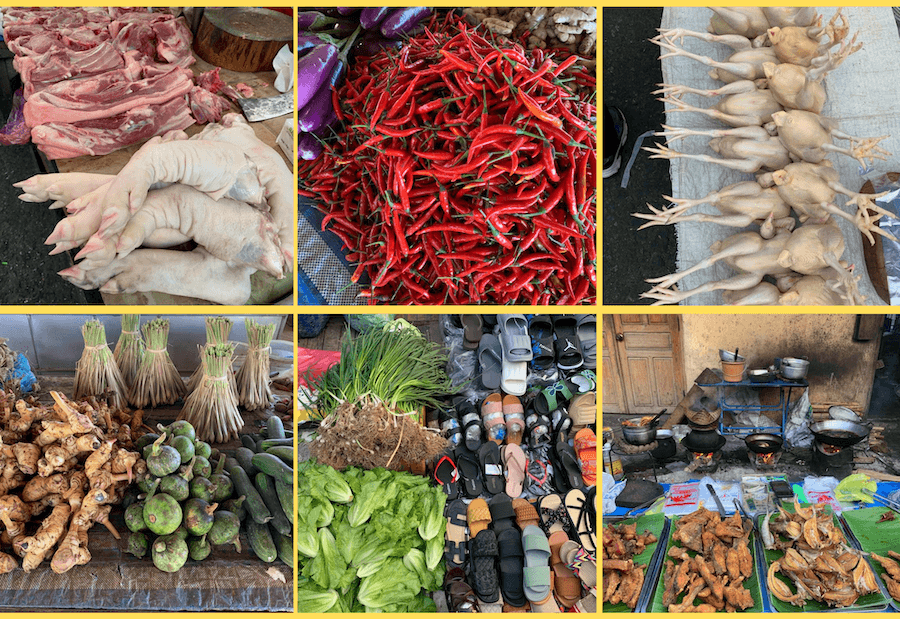
The market finds. * Photos: Heidi Sarna
Those who wanted to rouse before dawn could join a guide to watch processions of monks from the various monasteries walking in their saffron robes through the streets to collect rice and other alms.
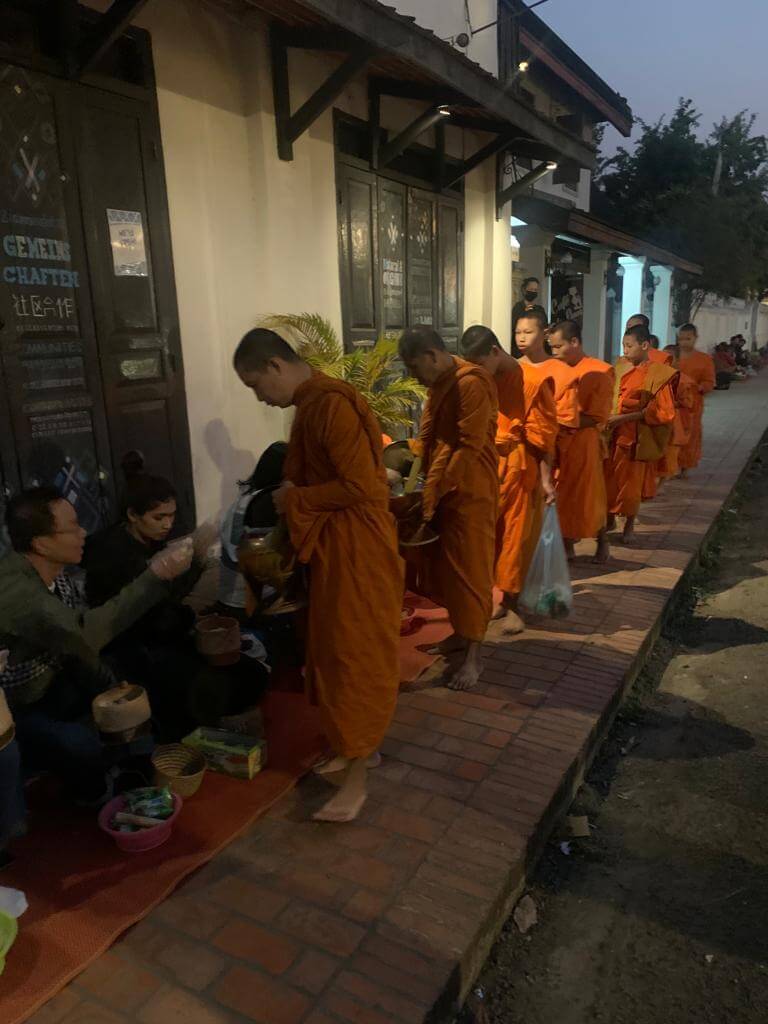
The monks receiving alms at dawn. * Photo: Heidi Sarna
One evening in Luang Prabang, a troupe of local dancers and musicians performed on board, ending the evening with the tying of white threads on our wrists for good luck, a ritual called “baci” done at important times like weddings and births.
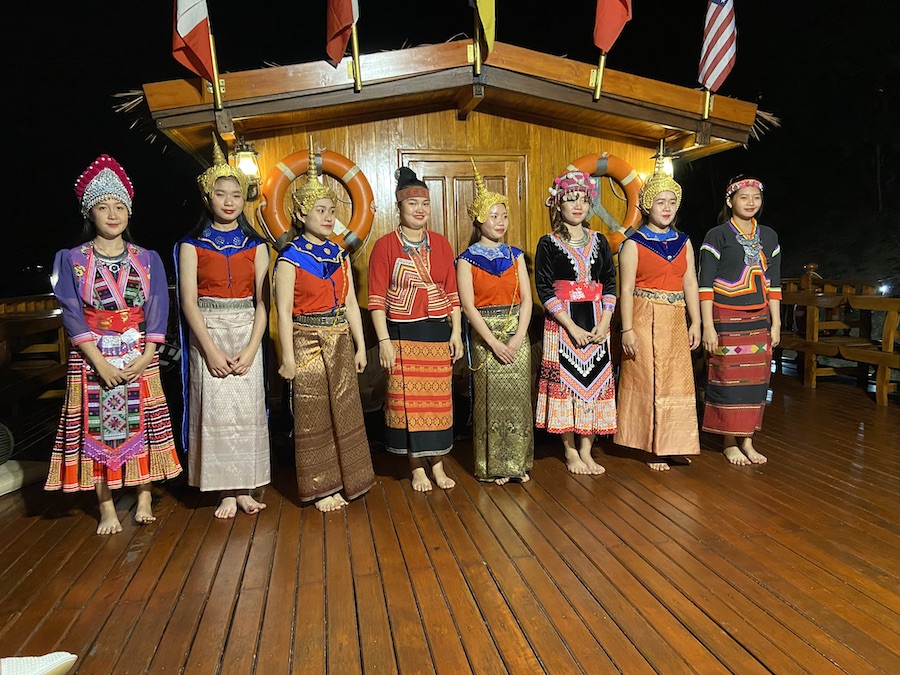
The dancers. * Photo: Heidi Sarna
The Xayabouri Dam
This is the biggest hydroelectric damn and plant in Laos; it’s about 80 miles downstream from Luang Prabang. It was fascinating to be aboard the Mekong Sun as it entered the steep sided chambers of the lock and then waiting for the chamber to fill with water before exiting “at the top” to re-enter the Mekong River and proceed upstream.
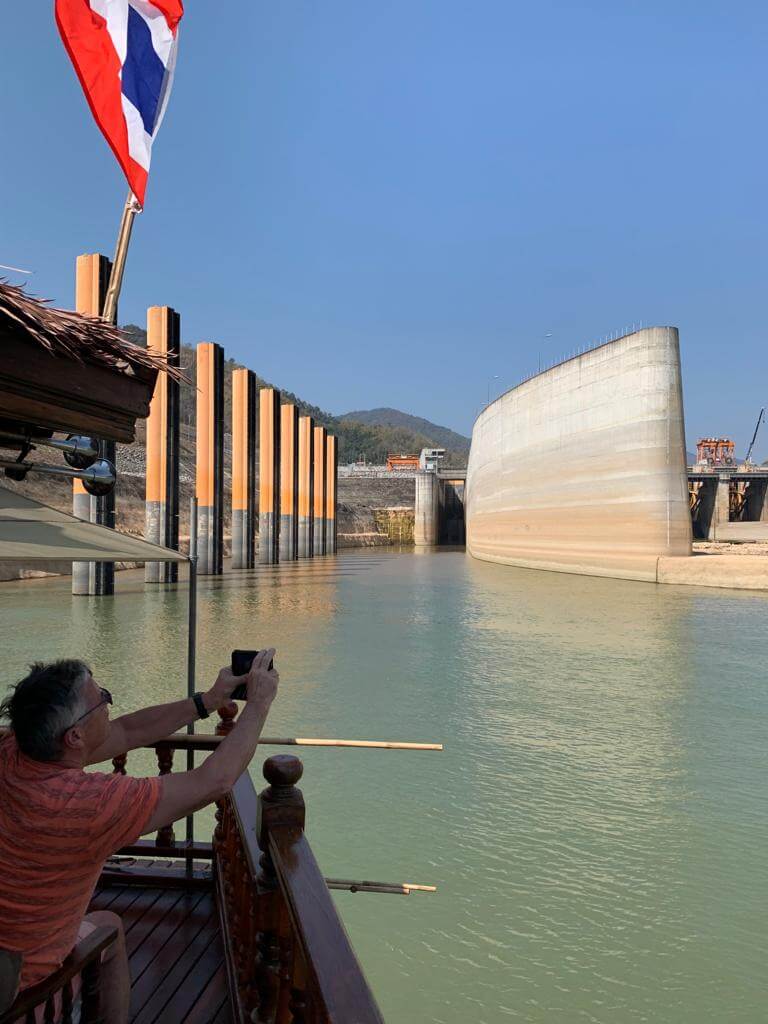
Approaching the Xayabouri dam. * Photo: Heidi Sarna
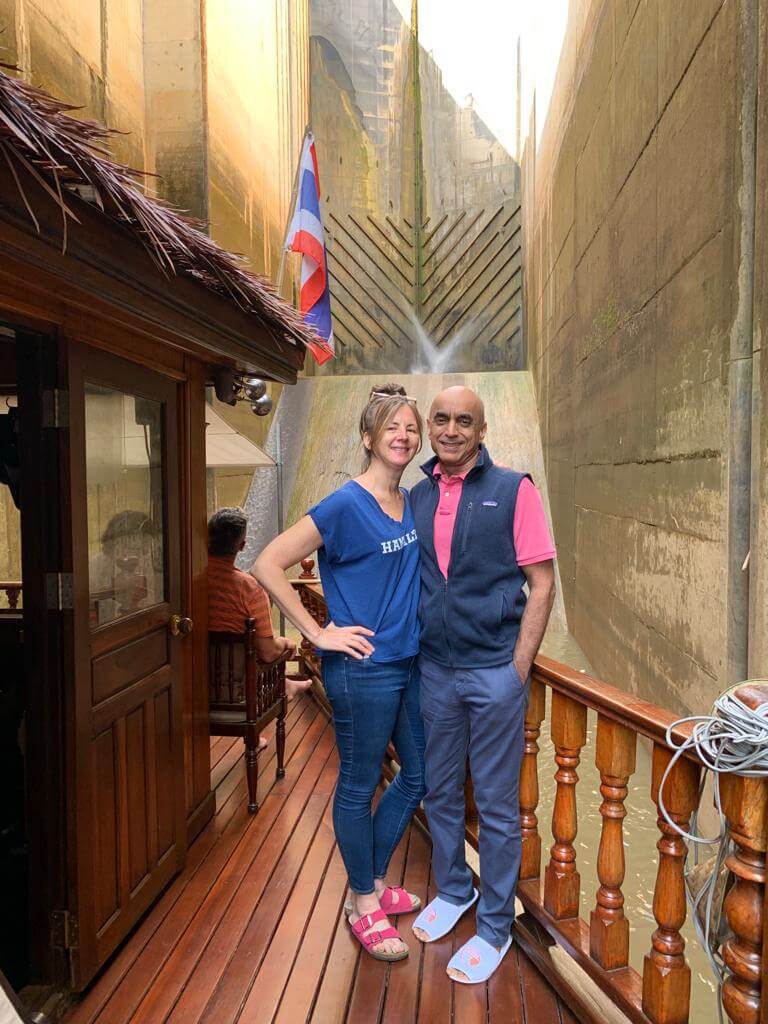
In the lock chamber at the Xayabouri dam. * Photo: Heidi Sarna
Dam building on the Mekong is a very controversial topic. They are typically built by Thai and Chinese contractors and the aim is for Laos to sell the generated hydroelectric power back to these two countries, with large populations hungry for it. (To compare the populations, Laos has about seven-and-a-half million; Thailand 72 million; and China more than one billion.)
While there are some economic benefits for dam building, the downsides are grave; namely the destruction of vast areas of farmland, whole towns and villages, and the fish and wildlife in and around the river.
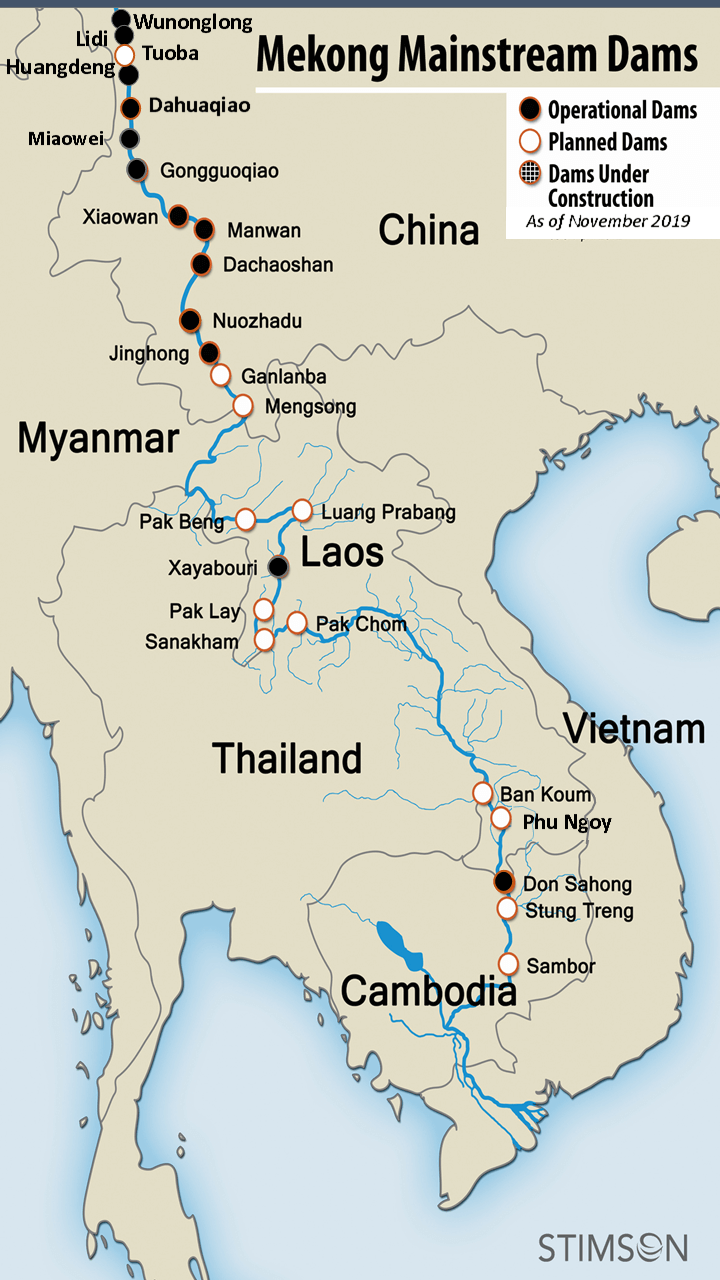
A map of Laos showing Upper Mekong River dams in progress. * Image: https://www.stimson.org/2020/mekong-mainstream-dams/
RELATED: Here’s an interesting report about the pros and cons of dam building around the world.
Dinner on the Sandy Banks of the Mekong
As mentioned at the beginning of my review, the dinner and bonfire set up in the sand one evening was a cruise highlight. Many of us were happily tipsy from the drinks and reveling in our good fortune of being on such an amazing adventure. Before heading back on board we released flaming paper lanterns into the sky so that are wishes and prayers would reach the heavens.
Upper Mekong River Cruise Tips
- Pack and dress in layers. The daytime sun can be warm (80s), while mornings and evenings can be cool (50s).
- No formalwear is needed; most folks wear what they put on the morning for the entire day, including dinner.
- Bring hats, sunglasses and sunscreen for your face.
- USD and Laotian Kip are accepted.
- Onboard drinks are reasonable ($1.80 USD for the local and tasty BeerLao in light or dark; $3.50 USD for a glass of wine from Chile; $1.80 USD for sodas).
- Be flexible. The itinerary is fluid, due to the morning fog and river levels, the captains move when it safe and pragmatic. Typically the engines start up at about 6:30 or 7am.
- Wifi is spotty; generally we’d have a decent signal for about 2 hours a day.
Dining Onboard Mekong Sun
The food served was delicious — fresh, healthy and well made.
Breakfasts and lunch were buffet-style. The chef made à la minute omelets with one’s choice of filling. There was also bacon, sausage, soft-boiled eggs, breads, yogurt, cereals and fresh fruit, including watermelon, dragon fruit, mango, papaya and tiny chewy sweet bananas that are like a different fruit compared to the giant stiff versions many of us are used to in North America and Europe. The buffet also included a selection of cheese and salamis, favored by European palates.
The buffet lunches were always appealing. For instance, one day there was a green salad and also a papaya salad with peanuts, and then local herbal chicken sausages, white sticky rice, sautéed local mushrooms (delicious!) and a minced pork curry that was so delicious I had two helpings. Dessert was fresh chilled watermelon and dragon fruit.

Delicious local fare aboard the Mekong Sun. * Photo: Heidi Sarna
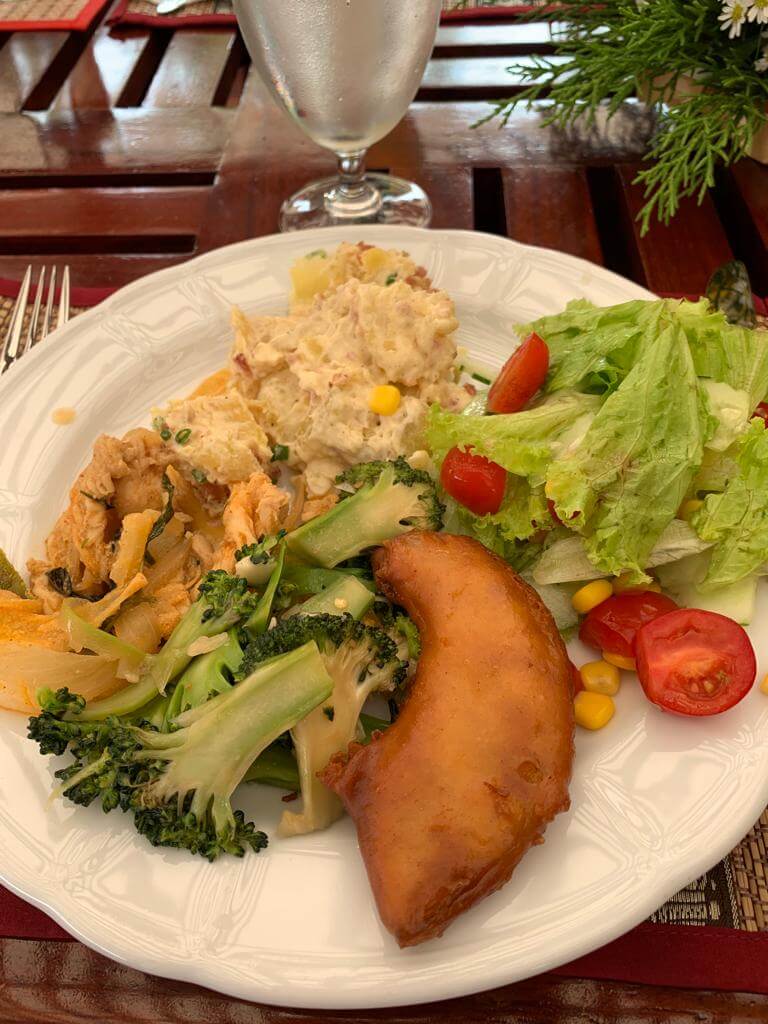
Delicious lunch and dinners made with local vegetables. * Photo: Heidi Sarna
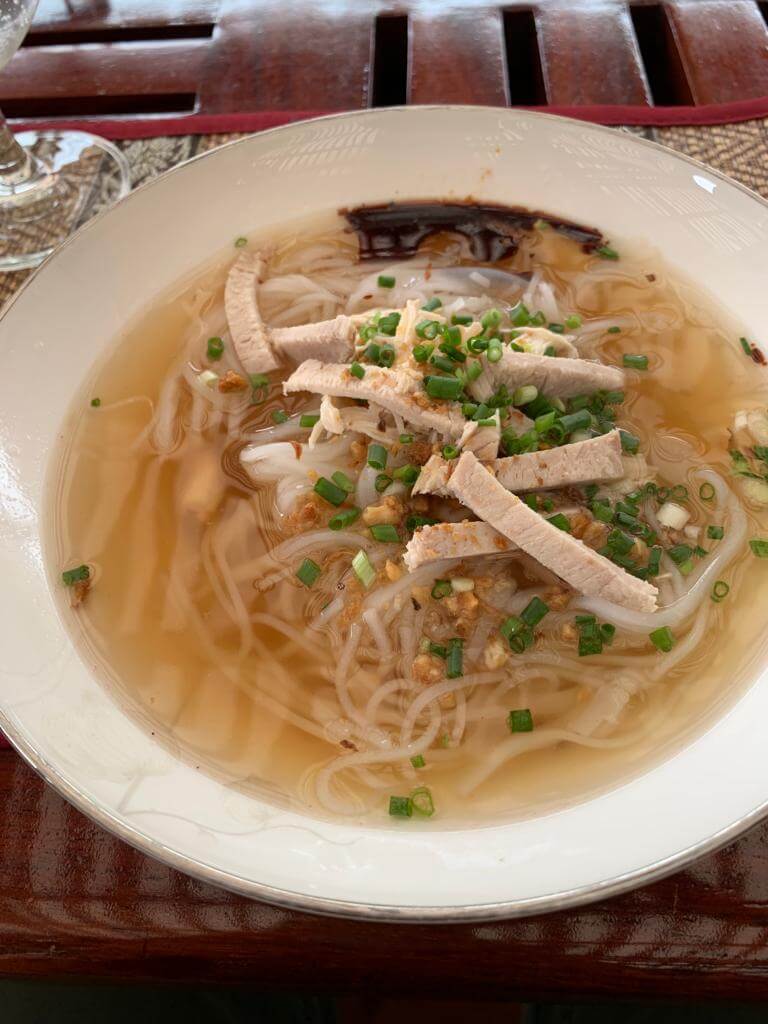
A delicious soup. * Photo: Heidi Sarna
Four-course dinners were always scrumptious too, starting with salads (Caesar), then soups (like pumpkin soup or mushroom), main course such as chicken and cashews, and finishing with desserts like chocolate cake with ice-cream and fresh fruit.
Drinks were reasonably priced.
Before dinner there was usually a talk by Alex about some aspect of Laos and the Upper Mekong, including information on the region’s tribal people and wildlife.
After dinner, some folks lingered with another drink while others turned in early. Most of us were in our cabins by 10pm or so. If some stayed later at the bar above, those of us in our cabins below knew it (but the noise wasn’t a problem for us).
Mekong Sun’s Cabins
Wood paneled cabins have two comfortable twin beds that could be pushed together; we slept well each night.
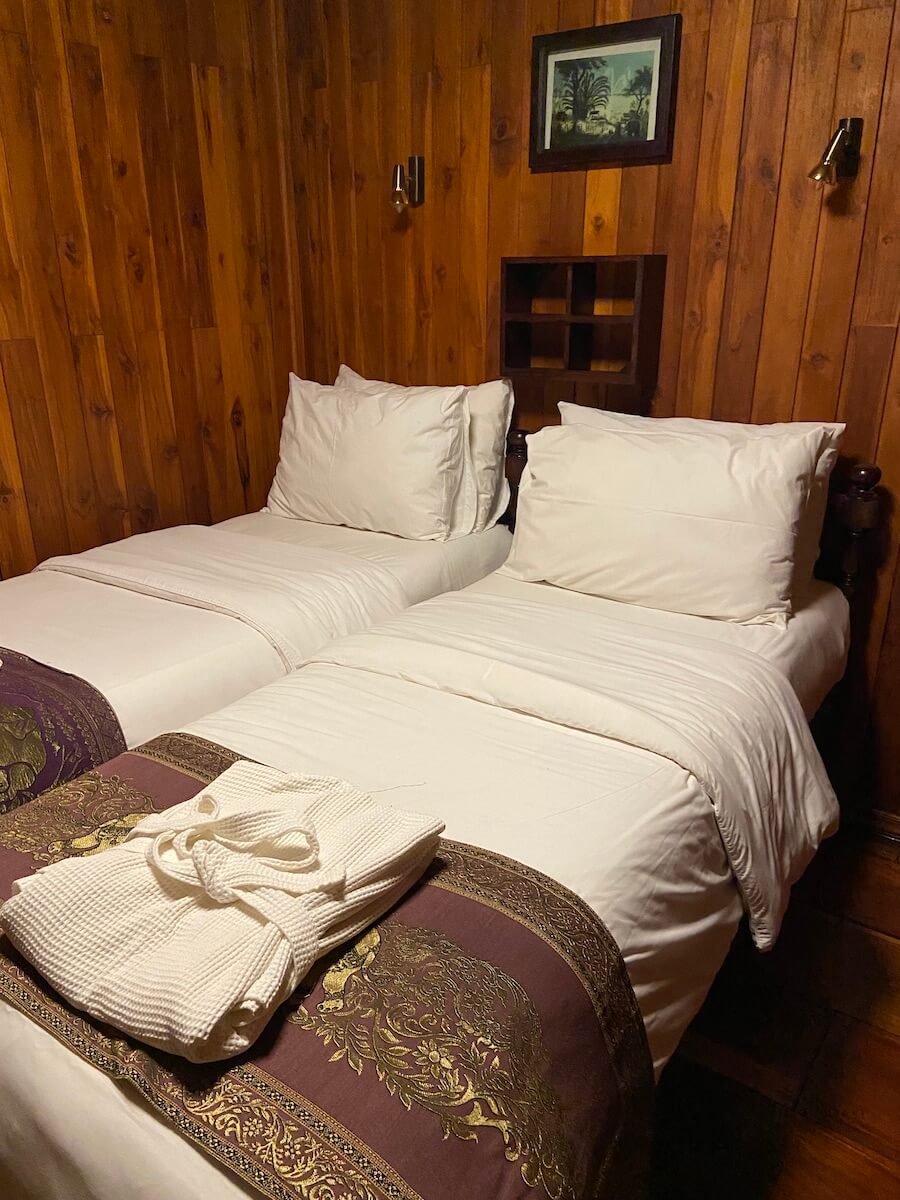
Our comfy cabin beds. * Photo: Heidi Sarna
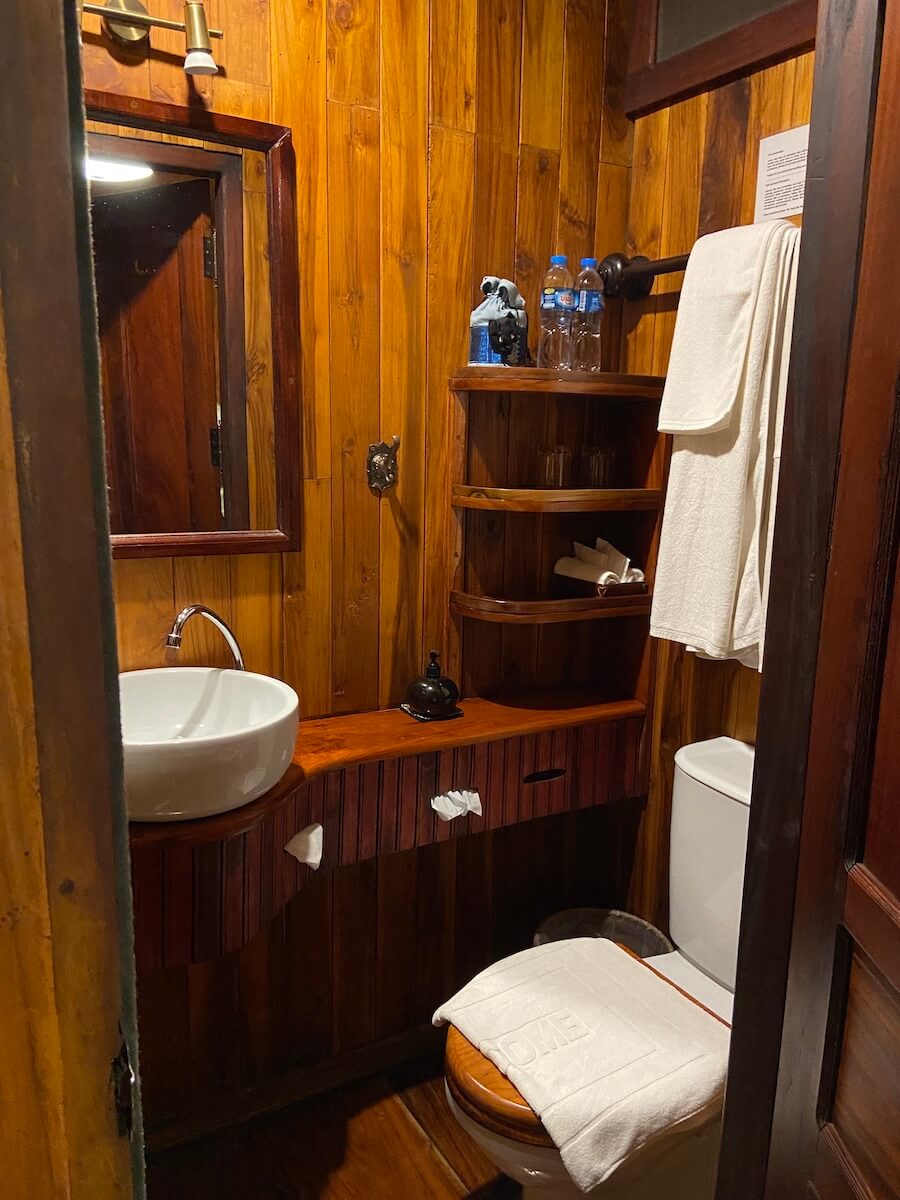
Our wood paneled cabin bathroom was very functional. * Photo: Heidi Sarna
I loved our large French balcony windows that slid open when we wanted fresh breezes, which is a great thing to do when boat is moving but not when it’s docked, as insects will come in.
There was a railing, so you could lean out a bit for million-dollar views and to hear the shushing of the boat moving through the river. All cabins have them, with two cabins sporting small sitting balconies.
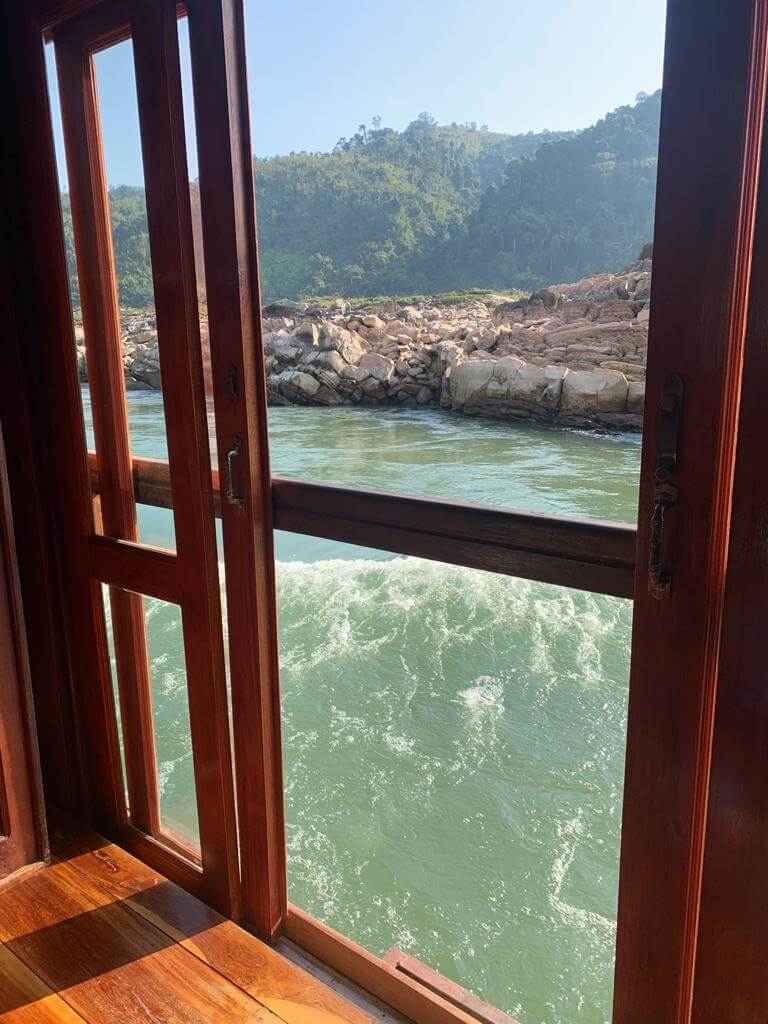
Always breathtaking views from our cabin French balcony. * Photo: Heidi Sarna
We liked that could control our room’s air conditioner, which we had to do often as daytime could be warm-ish and evenings cool.
The one closet was adequate, but not super big. The cozy bathroom wasn’t fancy, but I loved that it was also wood paneled, and everything worked well. The room also had a small desk and chair, and ample plug points for our devices.
Most cabins were on the lower deck, which also has a small library with a full-height French balcony, making it a lovely place to repose or read.
VIDEO: Here’s a quick video tour of my cabin, which was typical of most aboard Mekong Sun.
The Top Deck Of Mekong Sun
Half of the top deck was inside, with two long dining tables for eating when it’s too chilly or rainy outside (this happened only a few times) and also for pre-dinner talks. The breakfast and lunch buffets were also set up here.
The outdoor half of the top deck was partially covered and where you find the bar and two long tables for dining. There were also chaise lounges and deck chairs on the forward part of this deck for soaking up the sunshine and the views. One side of the far forward deck was for smokers. There were also a few seats just in front of the chart room.
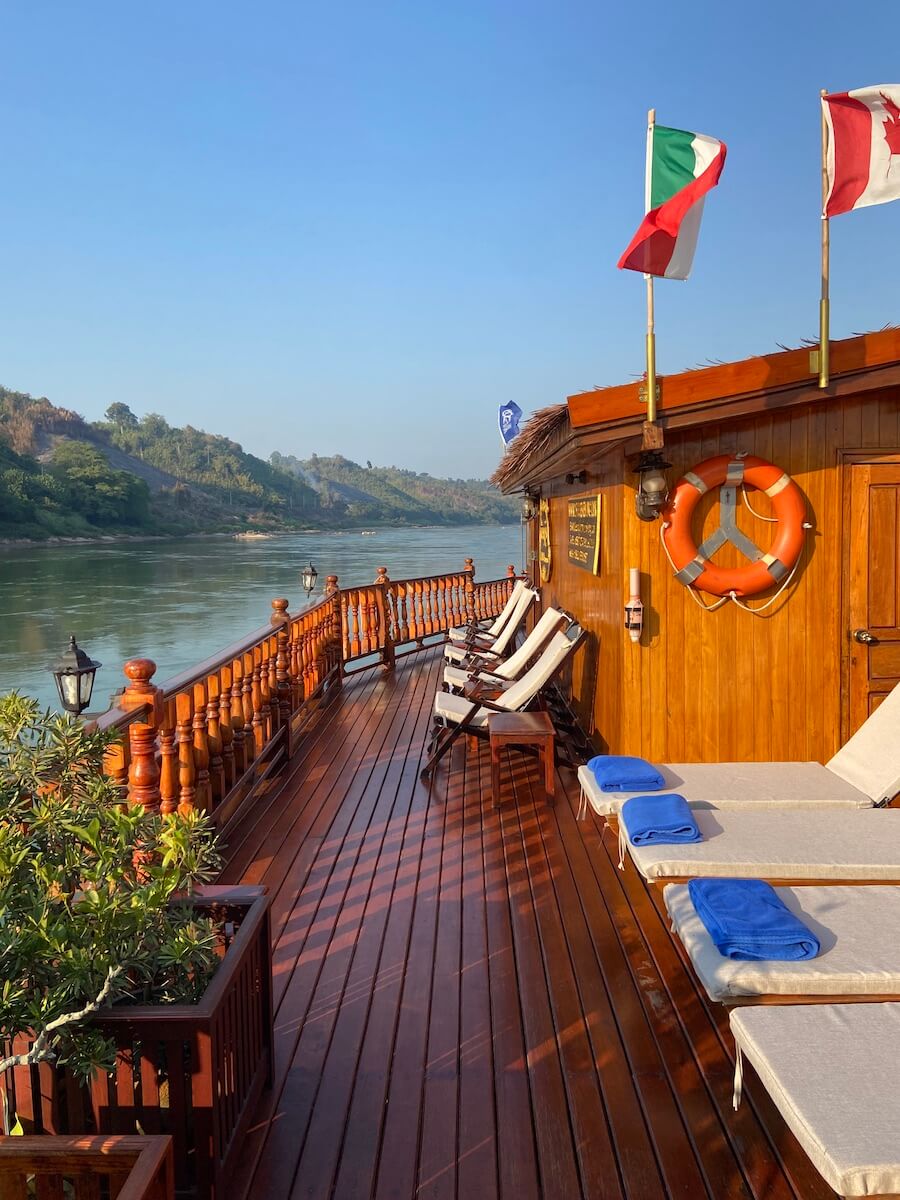
The top deck of the Mekong Sun, looking forward. * Photo: Heidi Sarna
VIDEO: Here’s a quick look at the top deck of Mekong Sun.
The Crew & Passengers Of Our Upper Mekong River Cruise
The entire crew of about 16 was from Laos and they were wonderful — friendly and efficient. The chef and his galley staff created delicious meals, the bartenders were on top of things, and our cabins were always tidy and in order.
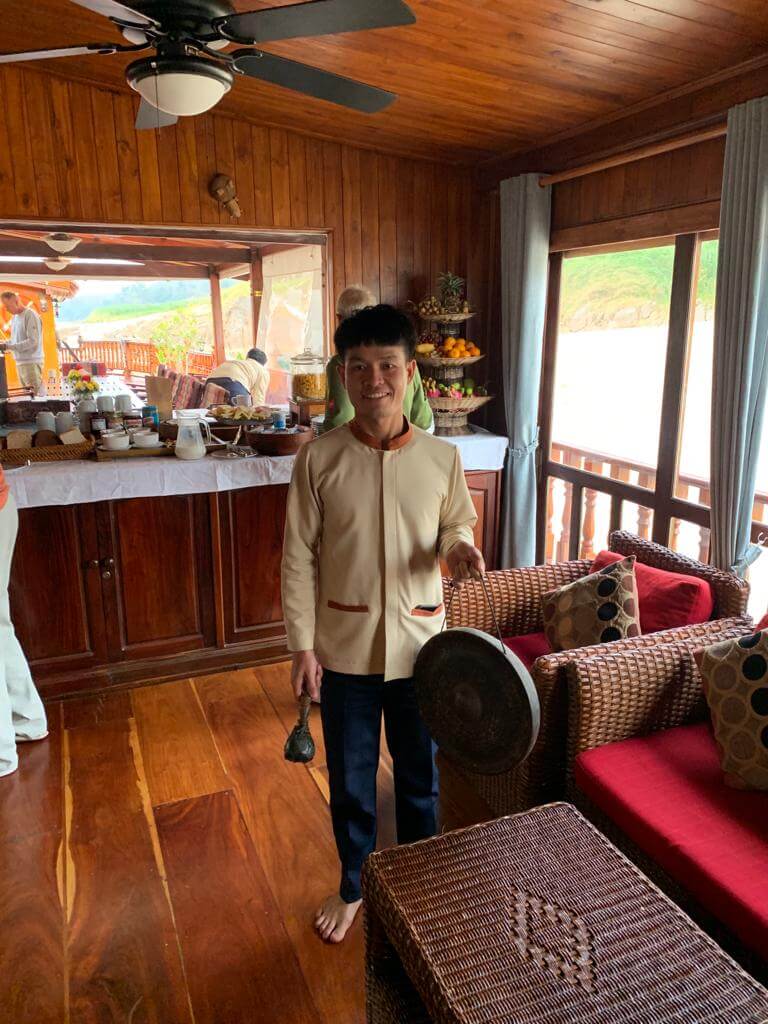
One of the wait staff, with the gong used to call us to meal time. * Photo: Heidi Sarna
Mr. Joy was one of the senior staff; he was the head waiter and also served drinks, since crewmembers on small ships and boats wear many hats. He spoke English very well and was always on hand to answer any questions we may have. He told me he loved his job and had been with the company for 10 years. His wife also works for the company, cooking the crew meals and working as the masseuse. (I booked a wonderful foot and leg massage, which was done in our cabin.)
We also routinely chatted with one of the handsome young bartenders who spoke English well, and to another senior crew member who assisted the captains and worked with cruise director Alex.
Fluent in English, Lao and German, Alex was born in Germany but has lived and worked in Laos for many years. He told us he was engaged to marry a Lao woman and would soon settle with her in Luang Prabang. Alex is one of three cruise directors who split their time across the two boats for the seven-month-long season.
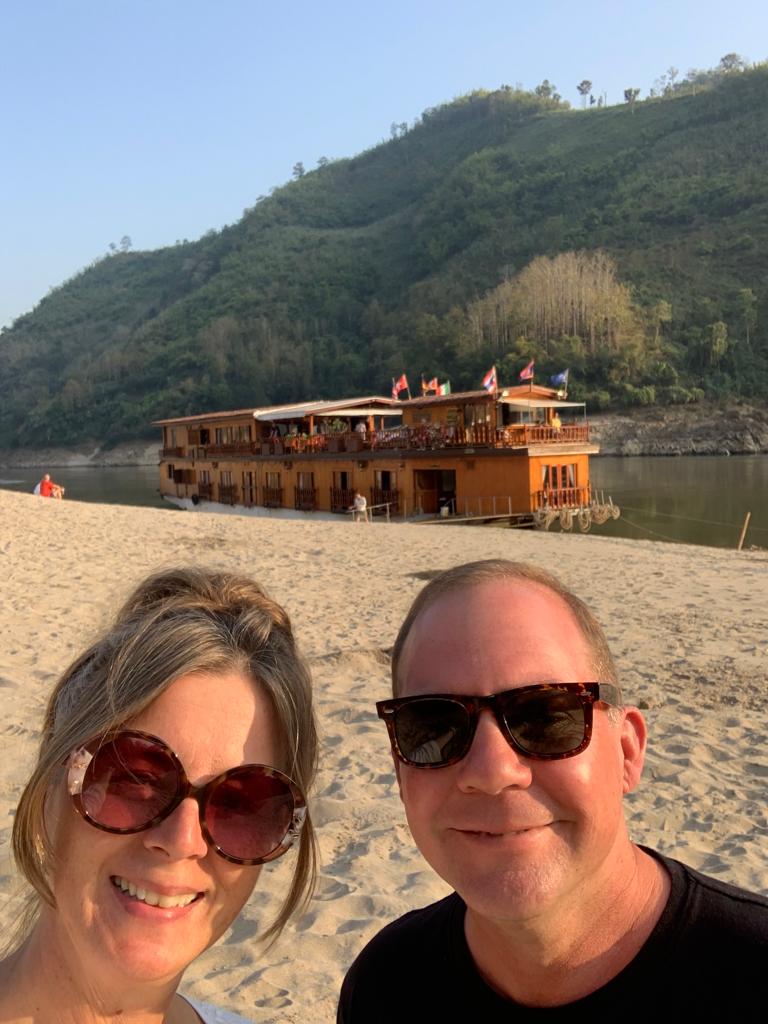
Heidi with Cruise Director Alex. * Photo: Heidi Sarna
VIDEO: Meet Alex, the cruise director of Mekong Sun.
Who’s On Board?
Mekong River Cruises — which operates the 28-pax Mekong Sun and the similar 29-pax Mekong Pearl on the Upper Mekong River — is affiliated with the well-established German-based travel company Lernidee, which specializes in train adventures and small-ship cruises.
While Lernidee offers its trips to a global audience, they’re very popular with Germans.
On our trip, there were two Canadians, two Americans living in Singapore (us!), one Italian living in Switzerland, and the rest Germans and Swiss. All were adventurous travelers drawn to offbeat places and quirky cruises. Most other passengers spoke some English, but not all. Overall, everyone was friendly. We mostly hung out with the Canadians and the English-speaking Italian, and two or three of the Germans.
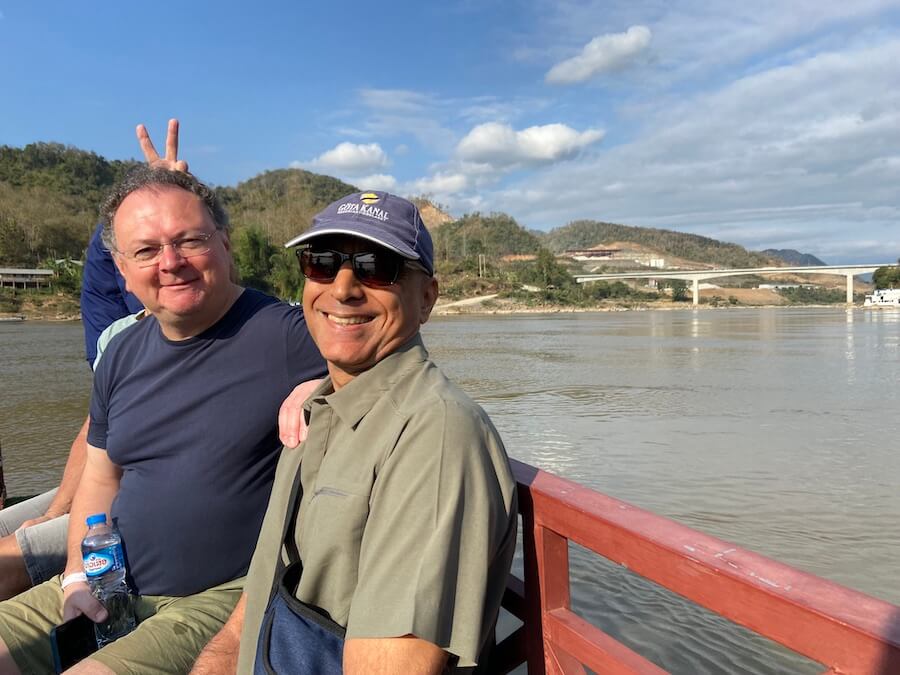
Our fun and friendly group. * Photo: Heidi Sarna
I originally thought I’d do an Upper Mekong cruise with Pandaw, a company I have traveled with before, but they were booked during the weeks I wanted, so I surfed around and found Mekong River Cruises. And what a find! We couldn’t have been happier with our cruise.
A Few Caveats
Except for the two busy port days in Luang Prabang, there’s lots of free time on the boat. Some days you’ll be in “port” for just one or two hours, so there’s a lot of time to sit on deck, read, chat, peruse the small library, nap, and watch the scenery. There are massages available too, which are done in your cabin. Every few days is a basic lecture — from “Dos & Don’ts in Laos” to “The Mekong & Dam Projects in Laos.”
When you’re in your cabin, you can hear people walking down the hall outside of your door and also above on the open deck. It wasn’t a huge issue as mostly everyone is on the same schedule — i.e., in port at the same time and mostly turning in within an hour after dinner ends, by 10pm-ish. If there were boisterous folks up on the top deck drinking and laughing until midnight, you’d be able to hear it from most of the cabins.
The Vibe & Pace Of Our Upper Mekong River Cruise in Laos
This isn’t a non-stop action cruise; it’s a very unique adventure focused on sitting back and soaking up the views and the vibes.
There’s a lot of down time on board, relaxing and chilling out on deck watching the scene along the Upper Mekong River unfold.
Sometimes it’s smooth water flanked by forests and vegetation, other times it’s moonlike and otherworldly, as if plucked from the pages of some ancient mythological text.
If you’re a curious observer and enjoy a slow pace and simplicity, this Upper Mekong River is for you.

The Upper Mekong in Laos as seen from Mekong Sun. * Photo: Heidi Sarna
I Wholeheartedly Recommend the Mekong Sun For Adventurous Quirky Cruisers
We enjoyed time chatting with new friends up on deck and taking endless photos of the fascinating riverscape. We also enjoyed relaxing in our cozy wood-paneled cabin, with its large French balcony/windows open to the breezes and river sounds. It was lovely and peaceful.
As on some other rivers, especially in Southeast Asia and India, seeing a country from the perspective of a river affords a vantage point you can’t get from travel by road or plane.
We greatly enjoyed our Mekong Sun cruise and highly recommend it. It was definitely one of my favorite quirky cruises.
Interested In This Cruise?
Fares for the 10-night cruise I took between Vientiane (in the vicinity) and Ban Huay Xay (near the Thai border) start at $3,160 USD per person, including all excursions, meals and transfers. There are also 6-night options of the Upper Mekong — round-trip from Luang Prabang, and between Luang Prabang and Ban Huay Xay.
Go to Mekong River Cruises for more details and to book this cruise. Or feel free to drop me a note with any questions, at Heidi@QuirkyCruise.com
Upper Mekong River Cruise Tips
How to Get There?
Fly via Bangkok to Vientiane, a 50-minute flight on airlines including Thai Airways. Or if you’re going downstream, take a short flight to Chiang Mai via Bangkok or Singapore, on airlines like Thai Airways or Scoot. From Chiang Mai, it’s a drive of several hours to Chiang Rai; from Chiang Rai it’s a two-hour drive to the Mekong River to board the cruise.
The Upper Mekong River Season
It runs from late August or early September through March or April.
RELATED: Judi Cohen reviews her Pandaw river cruise on the Upper Mekong.
Pre/Post Cruise Stays
I definitely recommend a few hotel nights on either end of the cruise.
We stayed in Vientiane for two nights before our cruise, at the charming Salana Boutique Hotel just a few blocks from the riverfront. A full breakfast is included at the attractive restaurant; for dinner, we’d skip the pricy French fusion menu there and head to one of the local places such as Papao along the same street the hotel is on, Chao Anou Road.
Similar to Thai food, we enjoyed the delicious Laotian vegetables and stir fry dishes with rice and chicken, and the yummy larb (a chopped sweet and sour meat salad), plus a couple of the local Beer Lao, all for about $10 USD.

Delicious food in Laos, here in Vientianne, similar to Thai food. * Photo: Heidi Sarna
We walked around Vientianne, known for its many monasteries, some with beautifully haunting chanting at sundown. We peeked in the window of one, seeing the devoted kneeling in prayer. There is also a market along the river, which is quite touristy with cheap clothes and plastic trinkets.
We also enjoyed our tour to the quirky Buddha Park, a sculpture garden with more than 200 Hindu and Buddhist statues. We hired a local tuk-tuk whose driver was hanging around near our hotel to take us there, about 12 miles away (he waited for us, and took us back to our hotel again; all for about $15 USD). The driver spoke no English, but he had a laminated flyer with information he could point to.

The Buddha Park outside of Vientianne. * Photo: Heidi Sarna
For the most part, Vientiane is not pretty despite its lovely name. It’s primarily a dusty hub and a convenient point of embarkation, being that Laos’ main international airport is nearby. Before our van ride to the Mekong Sun, there was a group lunch and a short tour of the city to see the golden Pha That Luang stupa and the Patuxai war monument, known as the Arc de Triomphe of Vientiane.
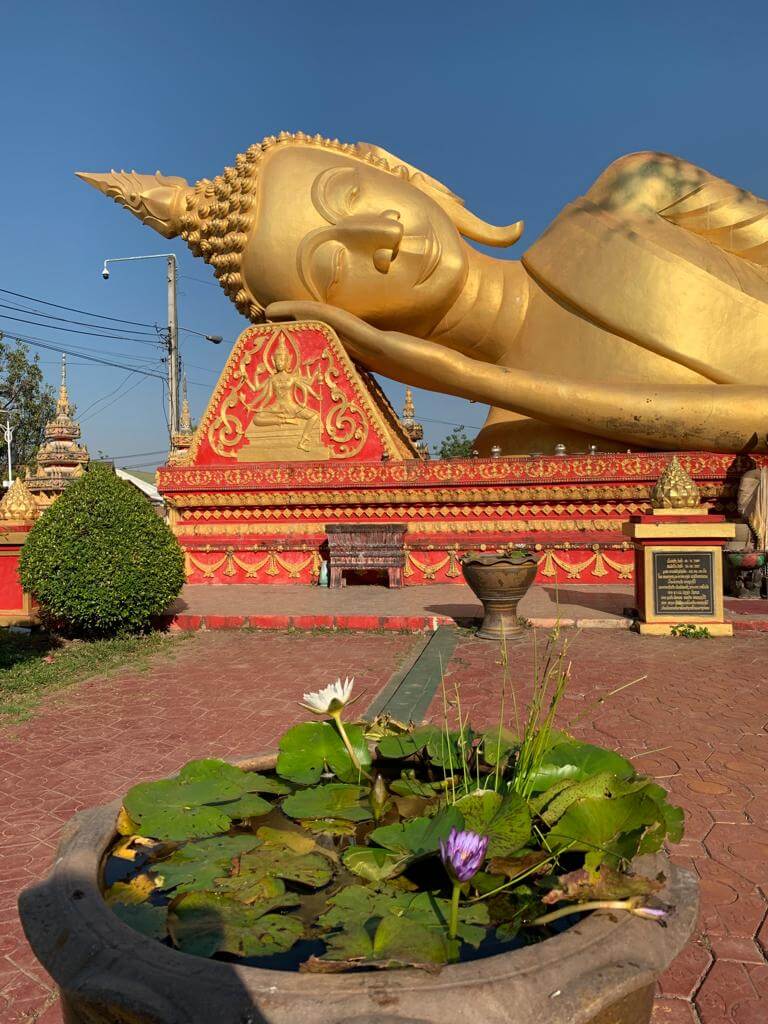
Part of the golden Pha That Luang stupa complex in Vientianne. * Photo: Heidi Sarna
After the cruise, we stayed one night in Thailand before flying back to Singapore. From the point of debarkation at Ban Huay Xay near the Thai border, everyone on the cruise was taken on a morning tour of the town that visited a temple with sweeping views of the confluence of the Mekong and tributaries at the Golden Triangle, where the borders of Laos, Thailand and Myanmar come together. (The term was first coined by the CIA in the 1970s to describe the opium-growing area of these three countries.) We then crossed the border into Thailand via one of the countries’ friendship bridges, aboard special shuttle buses one must use.
Once cleared in Thailand, we joined many in the group. My husband and I took a taxi to Chiang Rai where we and stayed the night at The Legend resort (arranged by Mekong River cruises).
While my husband napped, I had time to enjoy an excellent foot and leg massage in the hotel’s spa and we had a lovely dinner on the restaurant’s outdoor patio.
The following day we had an early evening flight back to Singapore. To make the most of our time, Cruise Mekong arranged a taxi for us ($150 USD each) for the four-hour drive (200 km) to the Chiang Mai airport, which included a stop at the ancient mountain temple Wat Doi Suthep.
Very popular with tourists, it’s home to a holy relic of the Lord Buddha and considered by many to be the most sacred wat in northern Thailand. There are about 300 steps to reach the top, which offers good views of the city.

The gilded Wat Doi Suthep temple. * Photo: Heidi Sarna
![]()
Don’t miss a post about small-ship cruising, subscribe to QuirkyCruise.com for monthly updates & special offers!
© This article is protected by copyright, no part may be reproduced by any process without written permission from the author. All Rights Reserved. QuirkyCruise.com.

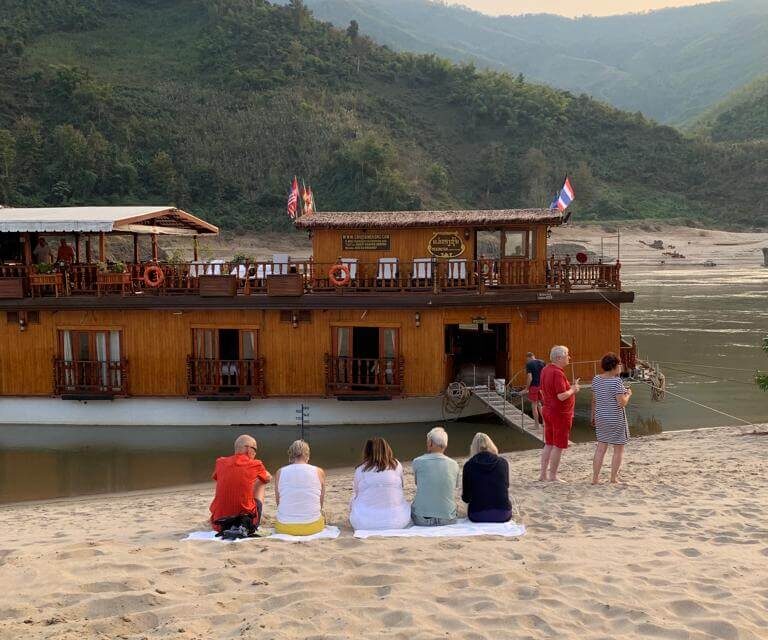
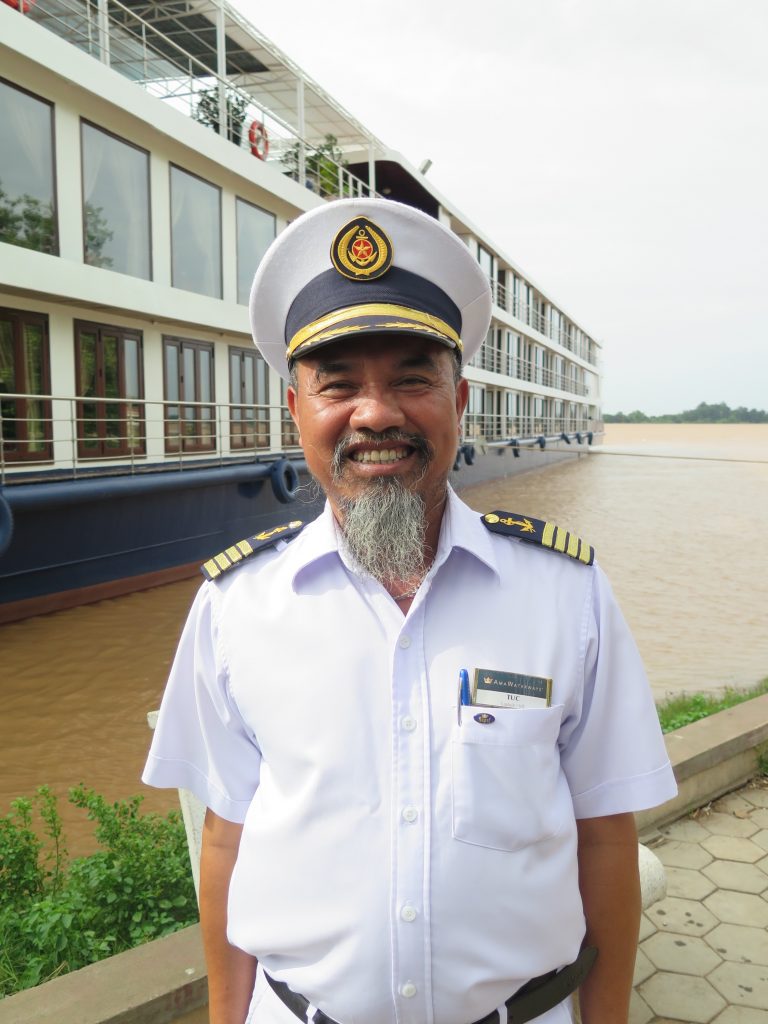
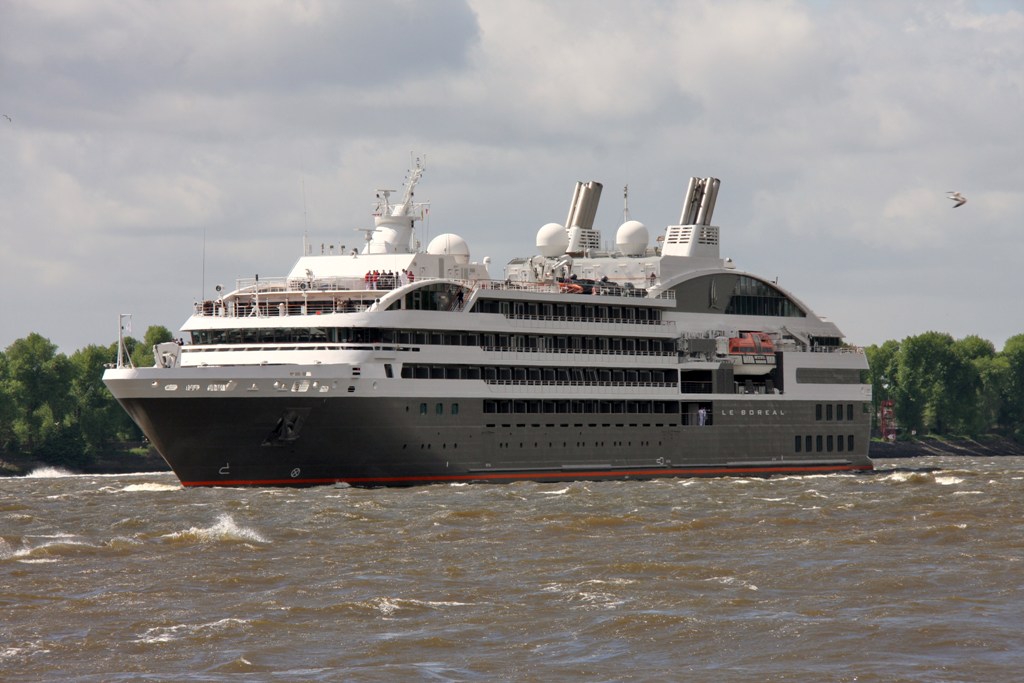
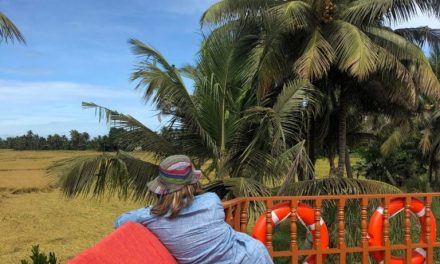
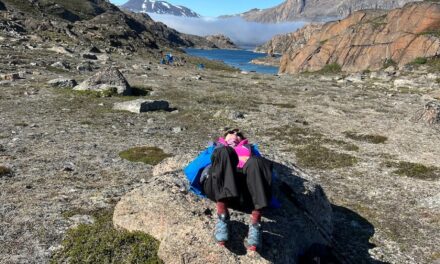








 HEIDI SARNA
HEIDI SARNA












What a wonderful story, Heidi! It sucked me in immediately and held my attention through your adventures, the food, what’s happening with the dam situation, the people on board (captains, crew and fellow passengers) and everything else. Beautiful writing about a compelling place! Thank you for sharing your extraordinarily quirky experience.
Thank you! It was one of my most favorite small-ship cruises … ever!
Thank you Heidi for this incredible report of our wonderful journey across the Mekong! Everything you write is true in my opinion! And by the way: I’m the German woman singing with you loud and joyful on the sandbank! I’m Sigrid. It was a pleasure meeting you!
Thank you!! It truly was an amazing trip!! And so nice to meet you !!(sorry I forgot your name ❤️)
Thank you Heidi, accurately described and beautifully written, and all is true, yes! Also thanks for the pics and your kind words. It is so nice to see everything and people on board again, plus you were able to shoot and visit sites that I missed, which is basically a good excuse to repeat this trip, perhaps downstream this time…
“Flaming tiki torches under the twinkling night sky.”
“…clusters of craggy moonscape-like rocks poking up through the water as if dropped from the sky…”
Bravo!
Thank you so much Adriano! So wonderful to have made a new friend on this very special quirky cruise!!